The importance of soft touch for healthy infant development
A huge amount of work has been done in recent years to understand the role of soft touch in how babies' brains develop. Here I summarise the major points in one page! It has been a great privilege to visit the Affective Touch conference in Liverpool and all the ACE-Aware Nation events in Scotland (with Nadine Burke-Harris and Gabor Mate) and to see all this research coming together.
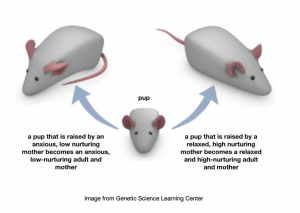
- it switches certain genes on and off, thus affecting cortisol receptor expression and therefore modulates the stress response. This was shown by Michael Meaney and his team; rat pups who were licked and groomed frequently by their mothers became high-licking mothers themselves. The DNA methylation of these high-licking rats and their offspring were different from low-licking rats. When a pup from a low-licking mother was fostered in a high-licking nest, this pup became a high-licker, and was found to display the same DNA changes. Behaviour had altered the expression of these genes, and these epigenetic changes persisted into the offspring.
- Soft touch reduces anxiety and pain, thought to be via effects on the HPA axis, parasympathetic system and oxytocin release.
- Deep pressure (as in hugs and massage) is also thought to play an important part in social touch, activating brain regions highly similar to those that respond to C-tactile stroking.
- Neonatal studies have shown the impact of soft touch (skin to skin) on improving long term neurodevelopmental outcomes, as they are thought provide a scaffold for the developing social brain.
- Soft touch and holding is know to help with regulating and stabilising cardiovascular parameters in premature babies and a good case for babywearing as a positive intervention has been made in a study in one NICU.
- There are positive long- term effects of supporting early mother-baby close contact. The "Family Nurture Intervention" studies suggest that at age 4-5, the intervention arm showed more healthy autonomic regulation
Soft touch also affects the hormonal systems of the body.
- Oxytocin is well known to be released by skin to skin tactile contact, as well as visual, auditory, olfactory stimuli, and works to promote further social interaction. Close contact stimulates release of this important hormone of bonding into both halves of the dyad (usually mother and baby).
- Oxytocin reduces stress and increases a sense of wellbeing and connection, and it has been proposed that regular skin to skin contact can shift the overall balance of the neurohumoral system away from sympathetic activation (stress, flight/fight) towards the parasympathetic/oxytocinergic system (calm and connection). With what we know about the effects of prolonged stress and cortisol release on health, this is encouraging.
It is clear that there are major benefits to the frontal closeness that babywearing in the early months and years can bring!
Further reading
Epigenetic programming by maternal behavior, Nature Neuroscience volume 7, pages 847–854(2004) Meaney et al
C-Tactile Afferents: Cutaneous mediators of oxytocin release during affiliative tactile interactions? Neuropeptides, Volume 64, August 2017, Walker et al
Pleasant Deep Pressure: Expanding the Social Touch Hypothesis Neuroscience, Aug 2020, Case et al
The Dual Nature of Early-Life Experience on Somatosensory Processing in the Human Infant Brain, Current Biology Vol 27 Issue 7, P1048-1054 Maitre et al
Babywearing as an intervention in the NICU Advances in Neonatal Care: September 29, 2020, Williams et al
Longer term effects of nurture on mother/child regulation Clin Neurophysiol Off J Int Fed Clin Neurophysiol. 2014;125(4):675-684, Welch et al
Why Oxytocin Matters, Kerstin Uvnas-Moberg, 2020
Neuroendocrine mechanisms involved in the physiological effects caused by skin-to-skin contact. Infant Behavior and Development, Volume 61, November 2020, Uvnas-Moberg et al
Top FAQS
These are the most common questions about babywearing I am asked, in a single helpful list!
Just click on the links to read the relevant blog posts, some are kindly shared from others
Firstly; some of my most popular articles:
Do the babywearing “rules” really matter?
Babywearing and infant mental health
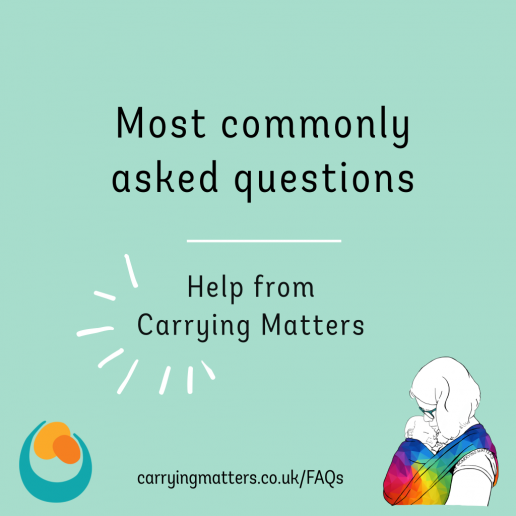
Secondly, I get this query daily. “Can I use your infographics to support families?” ABSOLUTELY! Everything on this website was created to help families with children to feel close and connected. Please credit me appropriately and link back to my website/social media (facebook, instagram)
Here is the link to the infographics (eg the Fourth Trimester/Build a Happy Brain/Why Carrying Matters/Skin to Skin posters, safe carrying images and much more)
Here is a search box to help you find what you’re looking for.
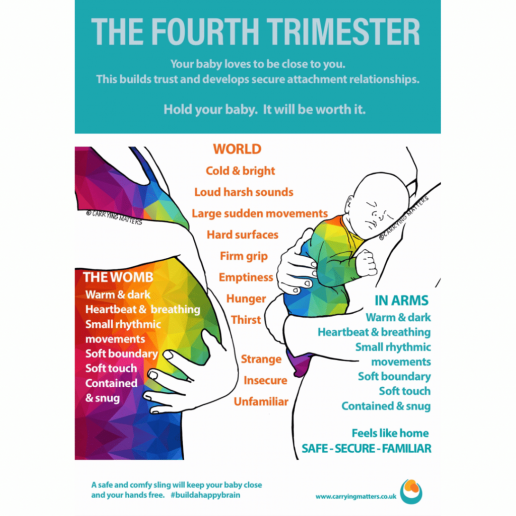
Getting started, and learning the basics
What kinds of sling are there and how do I use them? (links to the major types with useful guides, videos and troubleshooting)
How do I keep my baby safe in the sling?
Babywearing with a Newborn
What are the benefits of babywearing for my baby?
Are there any benefits for me too?
What are the best newborn sling options? (Coming soon)
How soon after birth can I carry my baby and what if I have had a Caesarean Section?
My baby’s head is so wobbly in the sling!
How high should my carrier be?
Can I carry my premature baby?
How do I protect my postnatal pelvic floor and babywear?
What about if I have a prolapse? (Thanks to Forest of Dean Slings)
Help! My child cries in the sling!
Does babywearing help my mental health?
Are slings useful if I have a perinatal mental health challenge?
Carrying in different circumstances
Can I sleep while my baby sleeps in their carrier?
How do I carry more than one child at a time?
How can I carry safely in hot weather?
How do I keep my baby warm while carrying in the cold? (ie can I put them in a snowsuit?)
How do I keep myself and baby dry when babywearing in the rain? (Coming soon)
Carrying adopted or foster children
What if my child has a disability? See this link for a stories from families living with a range of specific conditions.
Common safety queries
Will my sling hurt my baby’s hips?
What if I fall while babywearing? (Coming soon)
Skin to skin contact brings long lasting benefits
Skin to skin contact, also known as "kangaroo care", is one of the simplest yet most effective practices to help babies and their carers make the transition to life as a new family, supporting the development of essential bonds.
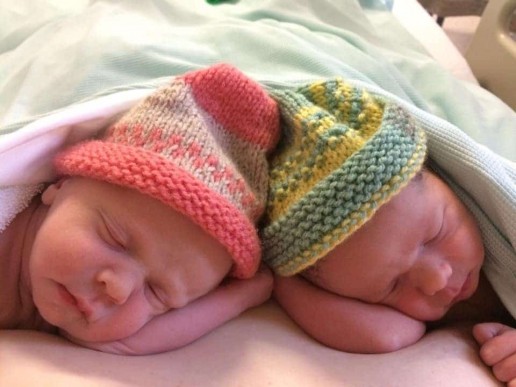
It is a major part of helping the baby to adjust to life outside the womb; the “fourth trimester” concept, and is highly important for supporting mothers to initiate breastfeeding and for carers to develop a close, loving relationship with their baby.
What exactly is skin to skin?
Here is the Unicef definition.
It is usually referred to as the practice where a baby is dried and laid directly on their mother’s bare chest after birth, both of them covered in a warm blanket and left for at least an hour or until after the first feed. Skin-to-skin contact can also take place any time a baby needs comforting or calming and to help boost a mother’s milk supply. Skin-to-skin contact is also vital in neonatal units, where it is often known as ‘kangaroo care’, helping parents to bond with their baby, as well as supporting better physical and developmental outcomes for the baby.
Why does it matter?
Outcomes for babies and their parents are better when kangaroo care is offered, especially with premature or low birthweight infants. A collection of studies examined outcomes for mothers and healthy newborns and concluded that there were clear benefits for physiological development, breastfeeding outcomes, emotional wellbeing. Other studies are helpfully summarised here, showing enhanced bonding and attachment, and likely a direct impact on infant development by contributing to neurophysiological organisation and an indirect effect by improving parental mood, perceptions, and interactive behaviour.
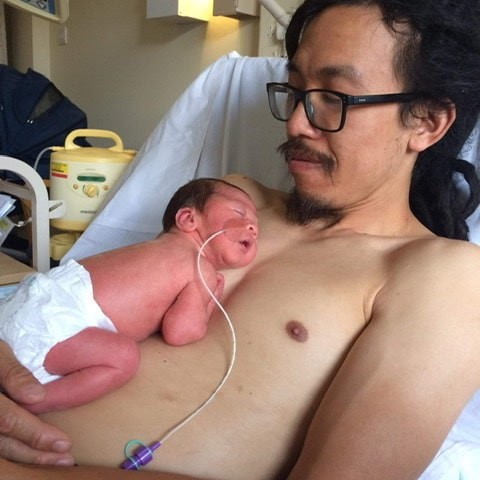
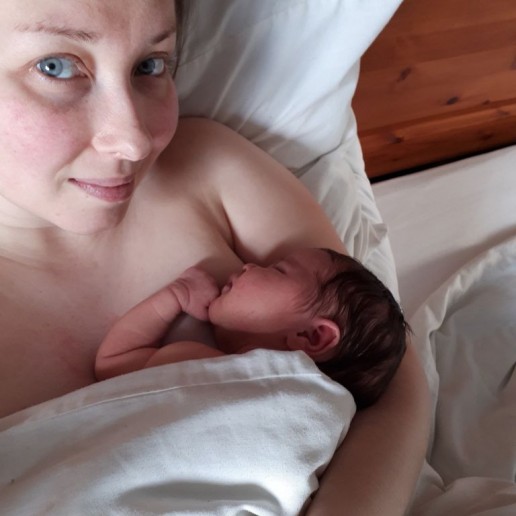
The major benefits of skin to skin care can be summarised in these images (thanks to Vija UK).
How is this thought to happen?
At birth, the neonatal brain has two critical sensory needs; smell and contact that is warm and soft. (Dr. Nils Bergman). Frequent skin to skin contact meets these needs in abundance, allowing the brain and the body to begin the process of adjusting to the outside world optimally, forging a pathway from the baby’s amygdala to its frontal lobe. This connects the newborn’s emotional and social brain circuits. Mothers also need early uninterrupted contact with their babies to fire up their hormonal response; that is, the release of oxytocin that helps breastfeeding and bonding to get going. Oxytocin and soft touch build connection and empathy, helping people to connect and care about each other. Studies suggest that an hour a day of skin to skin in the first 14 days is enough to derive long lasting benefits.
The mother’s body remains the baby’s natural home for many months after birth, and a policy of zero separation at birth is ideal for creating the conditions that allow new families to thrive. Fathers (and other primary caregivers) also benefit from skin to skin contact and this should be encouraged.
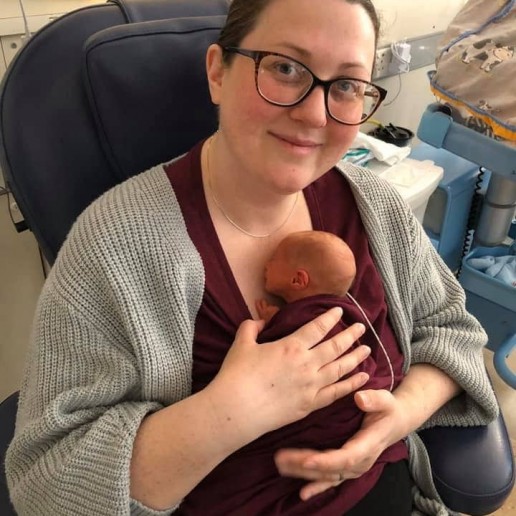
The impacts of this early contact are long lasting. Feldman et al in 2014 showed that kangaroo care “increased autonomic functioning and maternal attachment behaviour in the postpartum period, reduced maternal anxiety, and enhanced child cognitive development and executive functions from 6 months to 10 years.”
Skin to skin is clearly a fantastic thing; and the best thing about it is that the close contact in the early hours, weeks and months is normal human instinctive behaviour. It is free and effective; and should be available to all new families.
Simple wraps or specialised “kangaroo care” shirts can offer a more prolonged time skin to skin, and allow a parent/carer to move around, however it is the close contact itself, not the tool, that matters here!
What if I couldn’t do skin to skin with my child?
Not every parent/carer has the opportunity to experience skin to skin, for a wide range of reasons. This can be a source of sadness and concern, however, there are many ways to bond with your baby and help them to form secure attachments. Skin to skin is one very helpful practice, but it is not essential for relationship forming.
Your ability to bond with your baby is not determined by your birth experience, whether or not you were able to offer kangaroo care at birth or later, how you feed your child or where they sleep. It doesn’t depend on your gender or your family set-up. Relationships form by experiencing a sense of connection and love. Children learn how to love by being loved. Playing, talking, cuddling, snuggles, reading to your baby, bathing them, being responsive and present are the things that matter.
Slings and Adoptive and Foster Families
We all know how vitally important it is for children to build secure attachments with their primary caregivers, both for a sense of security and belonging now and in the future. It is much harder for this supportive relationship to develop when the primary caregiver has difficulties of their own, and when children need to be taken into care. The adverse experiences being endured by children in these circumstances have been shown to have a long term effect on future mental and physical health
This page collects some of the most useful writing on the topic of sling use among adoptive and foster families.
Adoptive and foster parents will know that their children need all the love they can give; and a sling can play an useful part in building these bridges amidst the turmoil. The biochemistry of creating a secure attachment is not a conscious process, or one that depends on ancestry; the release of oxytocin and the down-regulation of the stress response that happens with consistent, close and loving contact happens in the background.
There are many other benefits in terms of language acquisition, socialisation, and also helping children to learn which of the adults around them are their primary caregivers.
Sue, a foster parent in the South, is a strong advocate of using slings as part of her care.
“Many of the babies who we care for have been exposed to either drugs, alcohol or domestic violence whilst in the womb. Carrying them has, without doubt, enabled them to develop into calm, sociable, happy, securely attached babies who meet (and often exceed) their developmental milestones.
Babies who have been neglected for the first few months of life can be very wary of people and situations. By carrying them they learn more about the world from a position of safety. They take cues from watching our faces and learn to trust people and situations more more quickly.
Using carriers when introducing babies to their adoptive parents show the babies that this is someone to be trusted. Only I carry the baby in a sling whilst they stay with me although many other people hold them. However from the first day of introductions the adoptive mother wears the baby in my (the baby’s) sling. I believe this shows the baby that Mummy (or Daddy) is a special person which enables the attachment to switch between us. “
“Children with disrupted attachments are often indiscriminate in who they seek to have their needs met by. Children should always be guided back to their parents by family and friends if they are approached by the child particularly for food and nurture. This process is called funnelling and is extremely important in giving a clear message to the child about who their primary caregivers are. A sling or carrier could be helpful in this process, reducing indiscriminate attachment seeking behaviour and discouraging over-enthusiastic family and friends from picking up and nurturing the child.” Carrying the Connection
This blog post from Slings and More (based in the North East) assesses the science behind how slings can help adoptive and foster parents to build secure attachments.
“Foster and adoptive families have an immense role in helping to form strong attachment bonds with the children they look after and to help those children who do not have strong attachment bonds to begin to form them.”
This is a personal account of a mother’s experience of using slings as she adopted a little girl.
Her father told her: “You two should have some time alone. She needs to learn your smell and the sound of her mama’s heart.”
Perinatal mental health challenges can be very real for adoptive parents too, and slings can be enormously helpful for all shapes and structures of family unit.
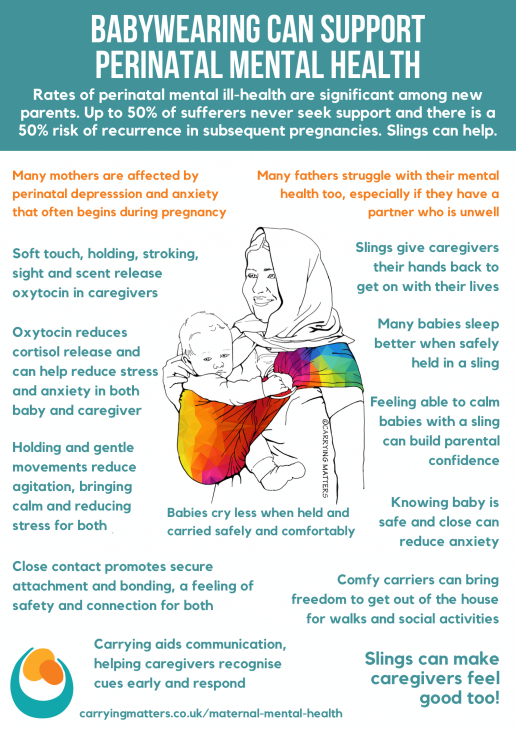
Bonding with your big kid
Bonding with your big kid is just as important as bonding with your baby. Older children need love and secure attachment relationships too, as their brains are still growing and their foundations still being laid down.
“I wish I had known about slings when I had my first child!”
“My son suddenly wants to be carried all the time suddenly and he’s so heavy now, I feel like we missed the boat.”
“My big girl is finding it hard with our new baby and seems to be much more clingy than usual. I wish I could carry her somehow..”
Do any of these comments seem familiar to you? I hear this kind of thing almost daily, and while part of me rejoices that now, at least, these parents do know how fantastic slings can be for family life, I appreciate their sadness.
But did you know, big kids like to be carried too? How many of us have hoiked our hefty toddlers onto our hips when their legs get tired of trundling along, or felt little arms wound around our necks when they are tearful? How many of our huge preschoolers still appreciate long hugs and piggyback rides? All children need closeness, long beyond the baby stage, long after they take their first steps, long after they start school… and so do grown ups! Loving contact is vital to our emotional health, from cradle to grave.
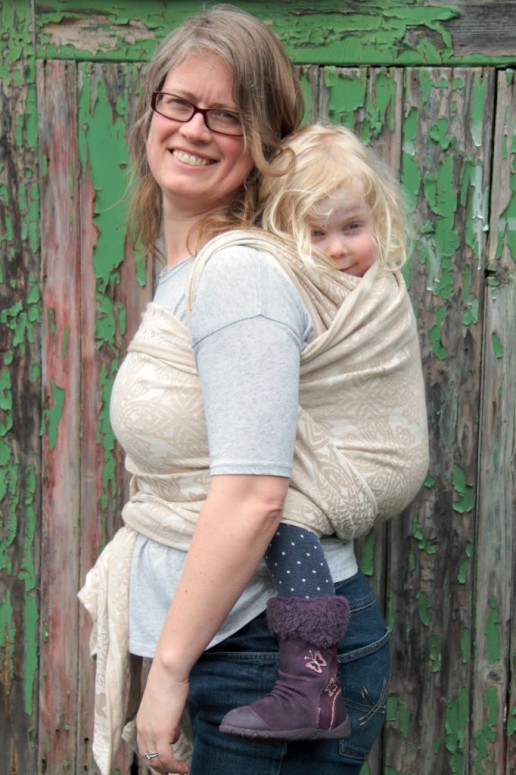
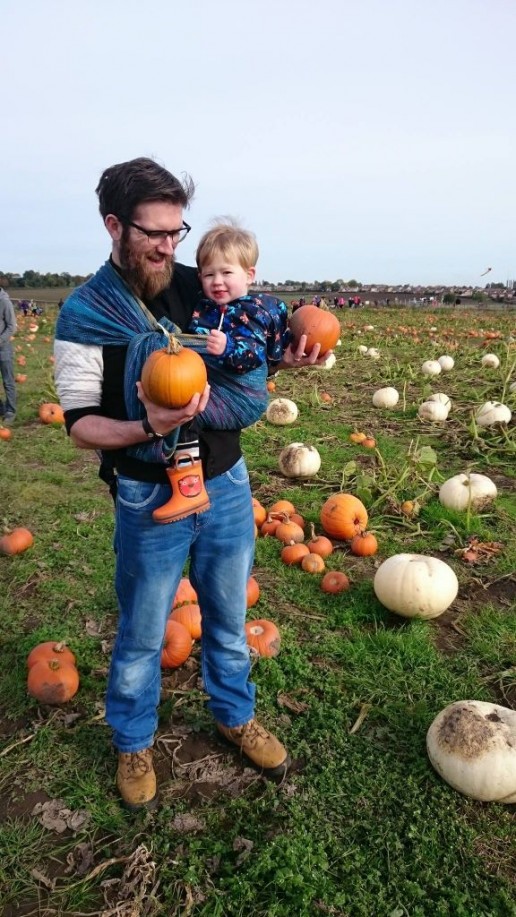
A sling is, at its most basic, a tool for enabling close contact, almost like another pair of enfolding arms around your child, while your real arms can be used for other things. A good sling, when used well, provides a feeling of all-around gentle pressure, as if being hugged all over. This can be very valuable for children struggling with sadness, with sensory overload, with tiredness, or fear from loud noises, for example. Being close to a parent’s body is reassuring and sends a valuable message to a child that “You are loved. I will look after when you are unhappy, I will keep you close when you need it. I am always here for you.” There are many other advantages to slings beyond this opportunity for connection; not least that they can be very comfortable and help to distribute the weight of a child around your body evenly, making it much easier and much less tiring than in-arms carrying. They can help to provide nourishment – breastfeeding or bottle feeding on the go, they can make school runs easier, allow greater freedom in exploration, enable naps, and keep exuberant runners out of danger in crowded areas or near roads etc.
Slings with Big Kids
You can use pretty much any kind of sling with a bigger child, even a stretchy, if it is a high quality hybrid one like the JPMBB or the Ergo wrap. I’ve helped a couple of parents with toddlers find the stretchy love, as there’s nothing quite like the enveloping gentle bounce you get with these. They do tend to work best and most easily in front carries.
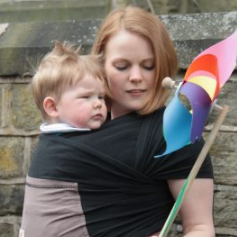
Ring slings can be fantastic, if you have the shoulder style that suits you best (pleated vs gathered), and made of a fabric that is supportive enough. People often suggest linen or hemp or silk to add strength to the softness of cotton, which indeed they do, but many 100% cottons are more than sturdy enough for heavy children, who can become easier to carry as they develop more core strength and become more compliant and easier to carry than the “bowling ball stage” – it’s worth trying a few out!
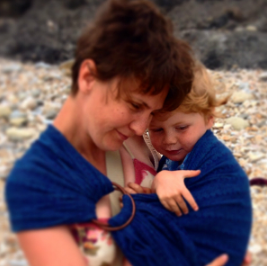
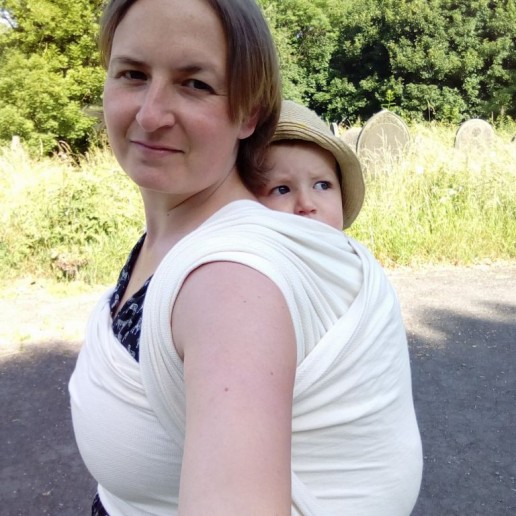
Woven wraps are the most versatile, as they can be tied in different ways, in different positions and with different levels of support. As with ring slings, the fabric used can make a difference to how a wrap feels – fibres with extra support can be helpful but may not be necessary, and as above, understanding tightening techniques and how to get a good position can really help you make the most of your current wrap
You can get toddler size meh dais, half buckles and full buckle carriers, even some up to preschool size. Again, it is worth trying a few out at your local sling library as one size does not fit all, and the body size and shape of the carrying parent plays a part too (some preschooler carriers will just be too big for petite mums, for example). Waistbands may need to be worn lower (around the hips) for front carries, and some creative methods for getting a good seat in a back carry may need to be employed! Please do take advantage of your local sling professionals about whether you need a bigger carrier for your child; it may be that your current carrier just needs a few tweaks in technique to get the most out of it. Many people upgrade to toddler carriers earlier than really necessary, and too big a carrier may be more problematic than one thats just a touch small (see my “beyond the knee to knee” article for more information).
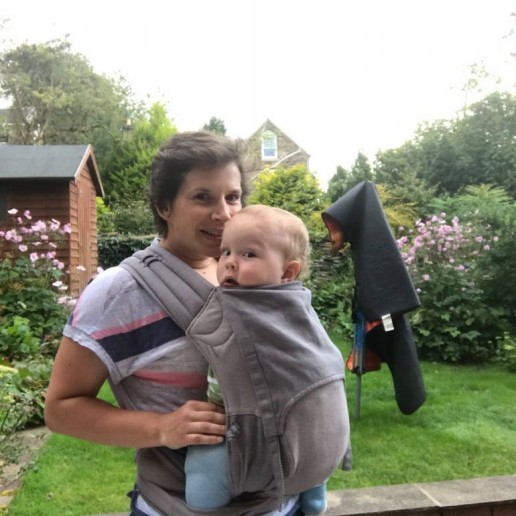
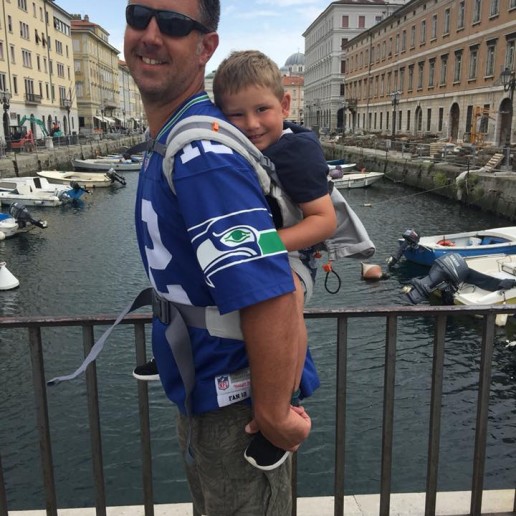
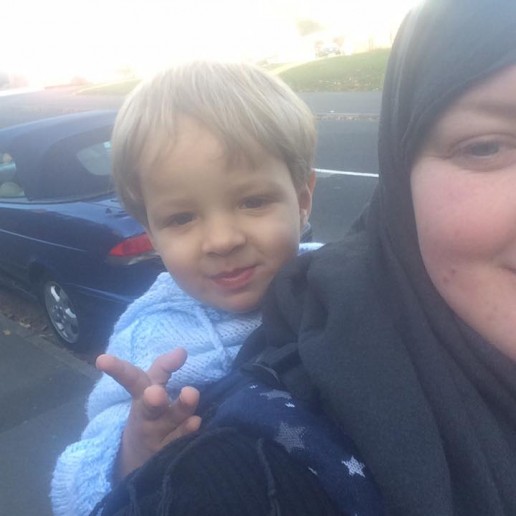
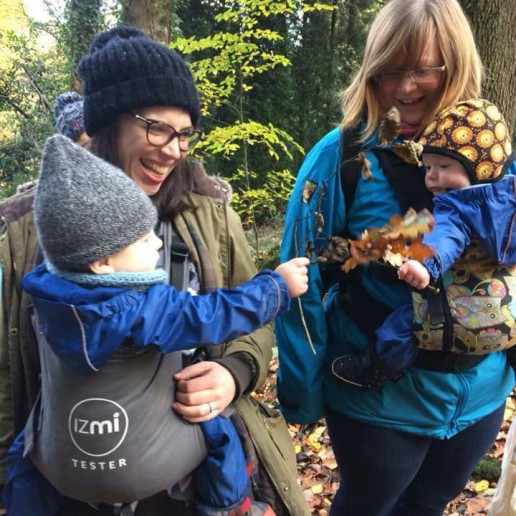
What about the inevitable comments “he’s too big to be carried like that, he should be walking!” or “You’ll just make that child clingy, you know”? Well, I think a sling is as valid a means of transport as a pushchair, and far more comfortable than achingly weary in-arms carrying. Don’t be afraid to carry your toddler – for every comment you get, you may well have planted an idea in someone else’s head. Ensure that your child doesn’t feel hurt by any comments, sometimes talking about any incidents together afterwards can be helpful. Using a sling for your bigger child from time to time will not harm them, nor will it make them babies again, any more than a hug or a hip carry would do.
My own experience
My big girl, who was nearly 4 at the time of writing, is much less often carried these days; much to my chagrin.. but she is vocal about it when she does want to be carried, climbing up me and wrapping her legs around my waist. I am happy to oblige as I’m never sure how many more carrying days we have left to enjoy. She has moods, and disappointments that the world doesn’t revolve around her, and sometimes she finds it hard to wind down. Often, at these moments, a sling has been our saviour, holding her close so she can relax, feel safe, and listen to my reassuring murmurs, while I can still get on with some of the things that just can’t wait, or save my back and arms from her lopsided weight! We use all sorts of carriers – ring slings for quick up and downs, woven wraps for sleepy cuddles, preschooler buckle carriers for rainy school runs, warm snuggly half buckles for winter walks.
Even my (then) six year old found a wrap carry a great reassurance one day when he got separated from us at the Yorkshire Sculpture Park; he was very distressed when found half an hour later and just wanted to be holding onto me. My husband’s shoulders got pretty tired after a few minutes; but I was able to carry F on my back for well over half an hour, due to the support and the weight distribution, enough time for him to feel reassured and connected again. I found it really helpful too – it was a pretty horrible forty minutes and having him in close contact was very valuable for my own feelings and allowed me to breathe and absorb, and move on.
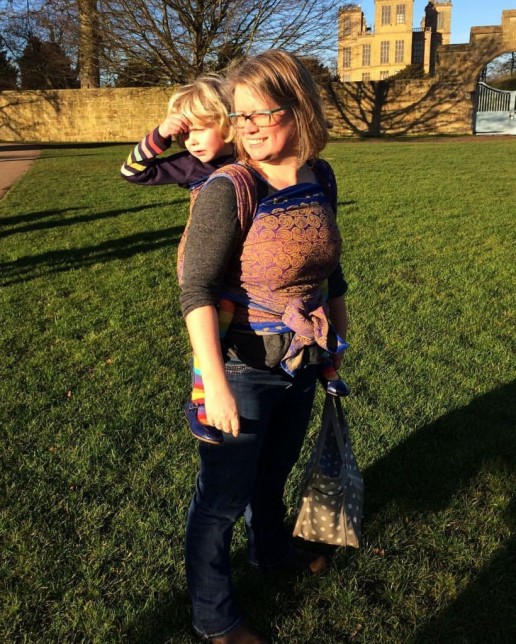
A local story of re-connecting with a sling
I’ve got to know one family with a preschooler pretty well, they hadn’t used a sling for over a year, but started again, almost from scratch. Here’s what they have to say about their experience of carrying a bigger child.
After starting nursery, H became anxious and disconnected. She chewed her fingernails to a painful point, and became difficult to communicate with, as well as regressing in toileting. Instead of adopting behavioural control techniques, I drew on my experience from other parts of our lives and adopted a regression tactic. A big part of this was returning to carrying her in a sling. We had used our high-street carrier rather than a pram on our dog walks, but had given this up over a year before as she had outgrown it. We wondered if a ring sling would be a solution for short snuggles for reconnecting. H was too heavy to attempt this from online videos, so we booked a workshop with a local sling consultant, who reassured us that she wasn’t too big, and showed us how to ensure we were all comfortable. The ring sling has been perfect for our needs and has really helped us all. More often than not, it has doubled up as a dramatic scarf for the 80% of the time H wanted to walk!
H is now almost 5. Our new buckled carrier is the perfect tool for winding down for bedtime on a camping trip, resting tired little legs whilst hiking (without the bulk of a framed carrier), and elevating her out of danger in busy, crowded areas. I really believe there is no such thing as “too big to sling!”
Slings with Two Kids
Another situation where carrying a bigger child can really help is with sibling jealousy. The other day I spoke to a family who hadn’t used their sling with their toddler for some time, and now have a new baby. Big sister has been feeling a bit jealous of the new arrival and has wanted to begin breastfeeding again. They asked for some advice, and I suggested that their daughter would really appreciate the contact that would come from using their ring sling and buckle carrier again… and so it seems to have proved. It’s not so much the desire to be a baby again, but more of a chance for communication – “you still belong to me, don’t you?”
I’m working with another lady whose older child is struggling to accept their brand new baby. She asked me to show her how to breastfeed her baby in a sling, in the hope that this would allow her to be hands free to play with her toddler. She’d never carried her first child but was loving the slings with the little one. Successful breastfeeding in a sling is a challenge that requires care to do well and safely, and in my opinion is never fully hands-free. However, one hand available can make a big difference – you can hold a book to read, help with a jigsaw at the table, stir a mixture, hold a hand, for example. Amongst other things, we looked at a ring sling, which can be used for little babies as well as bigger children who love to sit on the hip and look around, so it is a carrier that can be used for children of multiple sizes. Hopefully, carrying the bigger child from time to time while the baby is sleeping, or in a pram or carried by Dad will be helpful for dealing with big feelings and the need to know that his Mum is still Mum and will always be there to meet his needs, even with the new addition taking up so much of her time.
There are some carriers that can be used with small babies and bigger children; which means the same carrier can be used for both children when needed. The ultra- versatile ring sling and woven wraps are good examples, which mould around the parent-child dyad and can be used from birth to preschool age and beyond.
Some mei tais with adjustable width can work well for families with children born with a small age gap. The buckle-waist equivalent half-buckles can be useful, or those with wide wrap straps that can be tied in such a way that bigger children will be supported knee to knee. Some full buckle carriers can be used from birth and their panels can be adjusted to the size of the child. Some come with inbuilt adaptations for using with babies, and some have separately purchased inserts for small babies to rest on until they grow big.
Do visit your local sling library or get in touch with a sling consultant for some help navigating all these options; there will be something to suit nearly every situation!
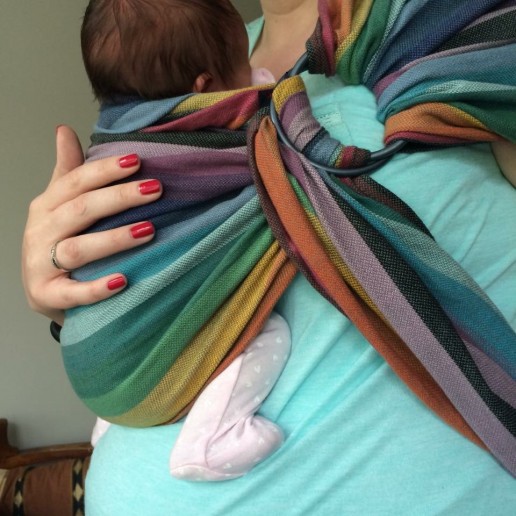
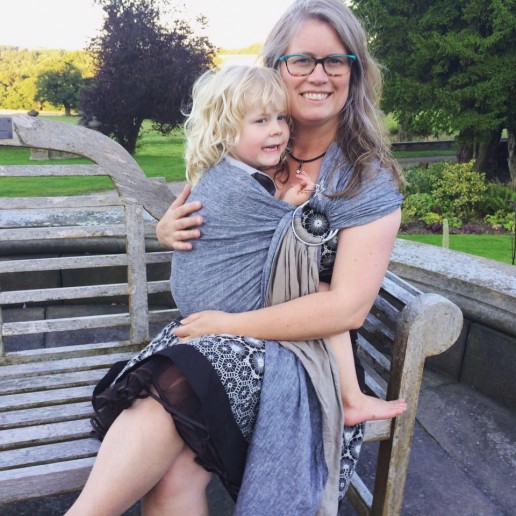
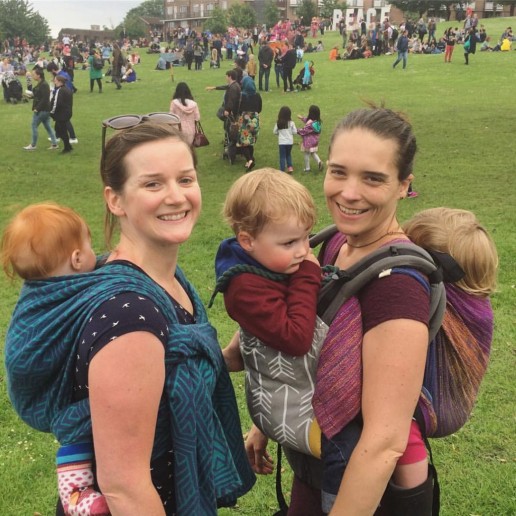
Slings during Pregnancy
During pregnancy, carrying an older child can be an opportunity to help deepen relationships and prepare for the new arrival, being reassuring that things really are going to be all right after all. Carrying while pregnant has its own challenges too; ensuring the bump isn’t compressed, that weight is well distributed, that any symphysis pubis discomfort is not exacerbated. Do see your local sling consultant or chiropractor or physio for help if you need (bearing in mind that many health care professionals may not be up to date with ergonomic, safe carriers.) There is more reading here about carrying while pregnant.
In summary, older children do not stop needing the love and support of their caregivers for a surprisingly long time. Our society seems to believe that we should encourage separation of children and caregivers as young as possible, to breed “independence”, when actually, neurophysiology suggests that children will learn independence at their own pace, as their cognitive and emotional capacities develop.
Secure Attachment and the "Fourth Trimester"
Secure attachment is the deep and enduring emotional bond that connects one person to another across time and space; a "lasting psychological connectedness between human beings" (Bowlby/Ainsworth).
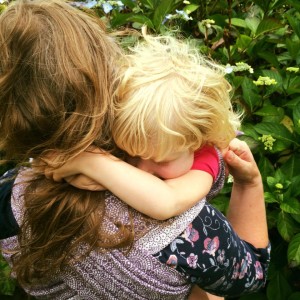
Research shows that one of the strongest predictors for insecure attachments in children is to have a parent who lacks secure attachment themselves.
So, how do you build a secure attachment relationship with your child?
Secure attachment is created by loving responsiveness to your child's needs. It is not about your parenting style. Your baby may sleep in a crib or your bed, be fed from a breast or a bottle, be held in arms or a sling, be weaned in any style, be brought up by any combination of carer and still have secure attachments. It is not about subscribing to a particular parenting philosophy. You do not have to sacrifice everything - your identity, your sanity, your relationship, your job, your money or anything else at the "altar of childhood".
Building secure attachment is about having respect for a child's personhood, building their sense of self-worth within a consistent, loving and responsible relationship, regardless of their age or understanding.
Your child's humanity is as valuable as your own; neither more nor less. You are your child's advocate in the world and their greatest defender. You can provide for their every need, and they depend entirely on you and your surrounding network. They will learn whether or not they matter from how they are treated and how their requests for support are met. Securely attached children are confident that they will be cared for, and that any distress will be met by love. They are easily soothed by their caregiver when upset, are more able to be self-reliant, form positive relationships and generally have smoother paths through life.
However, their needs need to be balanced with that of the family, as a crumbling family dynamic will ultimately not be in anyone's best interests.
The "fourth trimester" is where attachments begin to form.
What is the Fourth Trimester?
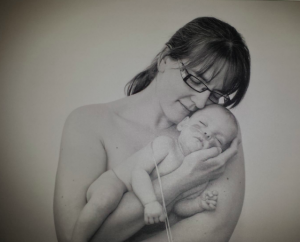
The ‘fourth trimester" is the period immediately after birth, a few more months of intense nurturing to allow a baby to continue with their essential development from a place of security and safety.
A baby who has spent all their life growing peacefully in the womb, gently compressed by uterine walls at the end of the third trimester, will find the sensation being born, followed by freedom and open space in the outside world enormously different. Limbs that have been limited are suddenly free to stretch wide, darkness has turned to light, the muffled gentle rhythmic sounds of the mother's body have been replaced by loud, unfamiliar noises or deep silence. Constant gentle motion has turned into complete stillness or sudden movements. No wonder that when babies are held close, rocked and soothed, contained in soft boundaries once more, that they settle; this feels right and familiar.
The "fourth trimester” is all about gentle transitioning from the peace and stability of the womb towards active involvement in a new world.
A newborn needs to be supported to gain skills and strength at a steady, individual pace from the security of an unshakeable foundation and place of comfort and familiarity. Being held, close to familiar noises and scents is essential to development and positive learning; the infant brain is growing rapidly and forming new connections all the time. Connections that are reinforced frequently will persist into later life, whereas those that are rarely used will wither away. It is worth taking the time to ensure that these unconsciously forming connections are positive ones. Young infants do not have the cognitive development to behave in "manipulative" ways; but they do learn to trust someone who proves reliable time and again as these pathways are reinforced. They will be startled and upset when this love is withdrawn.
The importance of responsiveness
If you are sensitive and responsive to your baby as they begin to communicate their needs with you (by crying, wriggling, yawning etc) they will learn that they matter to someone. If they are uncomfortable, the people they are learning to trust will soothe them. When they are hungry, they will be fed, when they are tired, they will feel secure enough to sink into sleep. They will not be frequently left alone unattended for long periods of time, and will not be left to exhaust themselves in calling for someone who never comes. When they cry, loving arms will be there to comfort and keep them safe. These same arms will show them the world and provide a safe place that facilitates learning. Carrying matters; babies need it. It does not make them clingy, rather, the solid foundation of secure attachment relationships will be the springboard to confident independence later in life.
How does babywearing help?
One tool that can help you meet your child's need for loving contact in these early months is a soft carrier that holds them in a comfortable, safe and anatomically respectful position. Such carriers will help you to meet their needs to be close to you while allowing you to be hands-free for daily life. There are many other positive reasons to carry a child; such as reduced crying, reduced plagiocephaly and more. Parents benefit too, for example carrying can be helpful for those with postnatal depression, and increase overall activity levels. This idea is not new; most of the world’s families across history and cultures have used some form of sling to make life work.
You can find out more from your local sling library or consultant; there are hundreds across the UK. They will help you to find the right type of carrier for your needs.
What about my older child?
Attachment relationships continue to form beyond the early months and children's brains are very "plastic". Warm, responsive, emotionally available parenting will help to build a child's sense of self-worth at any age. There is evidence that "mind-minded" parents (ie those who treat their children as intelligent, relational individuals with feelings, and speaking to them in such a way) seem to have children with more secure attachments. Active play and laughter, as well as consistent loving boundaries help to reinforce neural connections that the primary caregivers are a reliable source of security; forming strong foundations for the future. Read more about how carrying can help the learning brain.
References
Bowlby J. (1969). Attachment. Attachment and loss: Vol. 1. Loss. New York: Basic Books
Ainsworth, M. D. S. (1973). The development of infant-mother attachment. In B. Cardwell & H. Ricciuti (Eds.), Review of child development research (Vol. 3, pp. 1-94) Chicago: University of Chicago Press.
Ainsworth, M. D. S., Blehar, M. C., Waters, E., & Wall, S. (1978). Patterns of attachment: A psychological study of the strange situation. Hillsdale, NJ: Erlbaum.
Sutton Trust; Baby Bonds Parenting, attachment and a secure base for children. March 2014 Research by Sophie Moullin, Jane Waldfogel and Elizabeth Washbrook
http://www.parentingscience.com/attachment-parenting.html
Rethinking Maternal Sensitivity: Mothers’ Comments on Infants’ Mental Processes Predict Security of Attachment at 12 Months; J. Child Psychol. Psychiat. Vol. 42, No. 5, pp. 637–648, 2001
Sling Training for Child Care Providers
Many parents are now expecting their child care providers to have some knowledge of safe sling use, and to use slings with the children in their care. In Sheffield, we provide training for those working in child care settings (as well as a module of the Early Years Parenting PGCE at Sheffield Hallam University). Here one of the course teachers explains why sling use in a child care setting matters.
Attachment in the Child Care Setting
Secure attachments with their primary care giver is vital to children’s social and emotional development. It helps them to grow into happy and healthy sociable beings.
The relationship between a child and their parents, is of course, paramount. But what about those children whose care is provided by more than one person? What if their care provider is absent for periods of time due to work or illness?
My husband and I work full time. Our two children have attended nursery since they were 6 months old. Between them they are at nursery for 80 hours per week. We have seen first-hand the difference that a strong attachment with nursery staff can make.
For those children who are cared for by extended family or private care providers, building bonds with those carers is critically important. A strong attachment with nursery staff can make a big difference to children’s happiness and comfort, and also to parent’s confidence in leaving their babies with a childcare provider.
Nurseries are telling us that prospective parents are asking if they practice babywearing. Parents are listing use of slings as one of the criteria they are using to base their decision of childcare provider.
Let us help you offer this service to the children in your care in a competent and safe way.
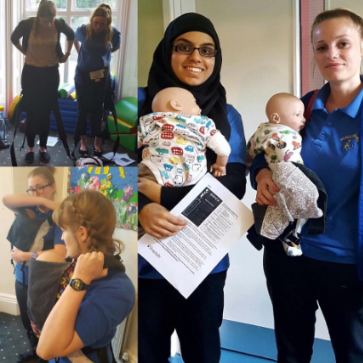
How can sling use help in child care settings?
Slings can help carers to hold children close, responding to their needs quickly and soothing children who are upset. Childcare providers tell us how they put distressed babies or tantrumming children into slings and feel them calm down, as they are rocked and swayed in the carrier, often falling asleep.
Slings are particularly helpful for providing familiarity for children who are already carried in slings by their parents. Using slings with these children can help replicate the routine they have at home and provide a familiar source of comfort.
Slings enable babies to be carried at height, seeing the world through the eyes of the person carrying them. It provides a new perspective for them, being able to observe how their carer interacts with the world, how they communicate with other people, how they behave. This observation and learning helps their social and emotional development as well as their language acquisition.
Slings also provide a safe haven for over-stimulated over-tired babies and children. Holding a baby close in a sling provides them with some respite and rest during a busy and active nursery day.
As well as the emotional and social benefits, for childcare providers, using carriers has obvious logistical and practical advantages. Slings can be used on day trips and walks, whilst one baby is in a sling, the same carer can push a double buggy, maintaining the 1:3 staff to child ratio.
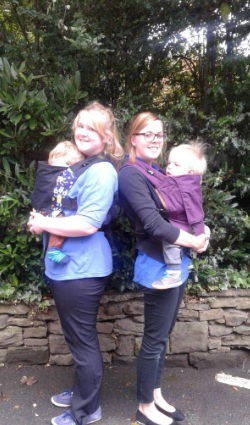
There are a number of circumstances in which slings could be useful for childcare providers:
-
Providing security and attachment
-
Settling-in and transitions
-
Replicating familiar routines from home
-
Encouraging bonding with multiple staff
-
Assisting in sleep and nap routines
-
Soothing and comforting babies/children
-
Going on day trips and walks
-
Quick carries around nursery buildings
-
Being ‘hands-free’ to look after other children
Different types of slings
There are several different types of slings that could be used. Each type of sling presents different pros and cons and some aspects to consider include:
- The age range it is best suited to
- How easy it is to learn and master
- Potential for trip hazards (for example from long straps)
- Potential for overheating (for example from multiple layers of fabric)
- How to fold, care for and store
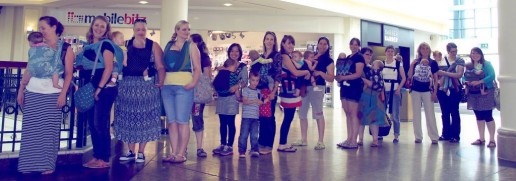
Safety Guidelines
Of course, whichever sling is used, safety guidelines must be followed. The most important aspect is to ensure children are able to breathe easily; once babies are over 3-4 months they can hold their own heads up and protect their own airways. Ensuring they are not too hot is also important.
The best known safety guidelines in the UK are the TICKS guidelines.
Comfort for children and for the staff matter, as well, so choosing a comfortable sling is a good idea, it is worth trying a few first. If you are a childcare provider using, or thinking of using slings, it is a good idea to undertake staff training and introduce a policy and consent forms. This will give you a chance to try some carriers and see what will work best for your needs.
Parental consent and the consent of staff members should be secured before putting a baby/child in a sling.
Carrying a Premature Baby, personal story
This is Kay and Alex's story of carrying a premature baby. She tells us about their lives together and what role slings have played in their rocky journey. It is a truly inspiring story of great courage and endurance and I am honoured to have played a small part.
"For as long as I can remember I have wanted to be a mum, but my real journey to parenthood started 5 years ago. I decided that I didn't want to wait for the "right person" to come along and started looking into fertility treatment for single women. Unfortunately the process wasn't was easy as I expected; after lots of tests and surgery I discovered that I had endometriosis which may affect fertility..
I started out doing IVI with donor sperm but after two attempts with no success it was suggested that IVF might have a better chance of working. I decided to take part in the egg-sharing programme to reduce the cost and hopefully help someone else too. During this time there was a lot of compulsory counselling to ensure I was aware of all potential outcomes. I'm very lucky that I have a fantastic support system of family and friends around me, especially my parents.
The first attempt at IVF was not straightforwards, I got 14 eggs, (7 of which were donated), but only one was fertilised. This was put back and I got a chemical pregnancy but miscarried. I also got a relatively rare condition called Ovarian Hyperstimulation Syndrome (OHSS) which made me really ill and I had to be hospitalised on numerous occasions. Due to the poor fertilisation rate it was thought that I had poor egg quality so had to pay the full cost of IVF treatment (as a single woman I was not entitled to any NHS treatment.)
On the second IVF attempt, medications were reduced to try lessening the risk of OHSS but because doctors were anxious about this, the egg collection was done too early and 5 eggs were lost during retrieval. This attempt was unsuccessful. I again got OHSS but much milder this time. The emotional rollercoaster or IVF is unimaginable and the hormones of treatment don't help! You spend all your time so focused on preparing to become pregnant, trying to stay positive, eat well etc, then once the embryo is implanted you have the longest two weeks praying you are pregnant and counting down to the day you can take a pregnancy test... but as soon as it is test day comes you don't want to do the test because you are until then "Pregnant till Proven Otherwise" ( PUPO). Internet support groups become your sanctuary because others undergoing IVF can understand what you are feeling, while your family and friends sometimes don't understand why you put yourself through so much. IVF became my only focus.
After the second attempt I had an eight month break to save up as I had used all my savings. I decided that the next would be my last attempt and I would do everything I could to try to help it work so I would have no regrets. I changed my diet (cutting out all processed food), saw a nutritionist, had regular massage (including Mayan abdominal massage) and acupuncture. We changed the IVF regime to one that had a higher chance of success but also a higher risk of OHSS. It was a risk I was willing to take. I had partly given up hope of this round working, as I got two fertilised eggs out of 19 when I began getting the OHSS symptoms again on day 2.
I did a home pregnancy test two days before test day..... and it was positive!
I didn't know how to react, so burst into tears before laughing maniacally then calling my best friend and my parents. The excitement wore off quickly though when I was admitted to hospital with OHSS at just 4+1 weeks. At a point when I had hoped that the hard part was over, it turned out that this was just the beginning of another difficult journey.
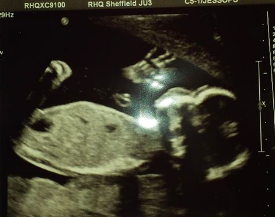
I continued to have tightenings but tried to ignore them as everything else seemed OK. Then exactly two weeks later after my scan at 21+6, I started with the smallest amount of bleeding. Again I was reassured as baby seemed OK and it had settled, possibly caused by a cervical erosion, and just to observe. I continued spotting on and off but nothing major, until I was at work on a shift on labour ward at 23+1 weeks pregnant.
I had a significant bleed and was terrified. I felt it was too far on in the pregnancy to lose the baby now but it was far too early to be born. I burst into tears. I am so grateful that I was at work surrounded by fantastic colleagues. I was admitted to the antenatal ward for observation overnight and I didn't go home again.
I continued to have tightenings and bleeding to varying degrees over the next three weeks. Getting to 24 weeks was a major milestone and I was given steroids to mature the baby's lungs. At around 25 weeks my waters went though because of the bleeding it wasn't obvious. Baby was breech and because of the situation I kept being told I might be taken for a Caesarean if bleeding increased or I went into labour. I saw paediatricians who told me stark statistics about survival rates and disability. As a midwife I knew these things but as a mum it just didn't sink in. I was tearful and losing hope. At 25+5 I had a major bleed that got me taken to labour ward and starved in case it continued and and I needed theatre. I spent the next two days in high dependency being observed and in denial.
Writing it down now it seems so silly but even given the bleeding, tightenings and water break it still never clicked to anyone that the pain I was in could be labour. At exactly 26 weeks I was found to be 7cm dilated. Two hours later I had a vaginal breech delivery complicated by the head getting stuck.
Alexander Benjamin was born weighing 1lb 12 oz and in a very poor condition.
The room was full of people but no-one was saying a word. Looking back at his notes now it says it took 18minutes to stabilise him before taking him to intensive care but it didn't feel that long to me. It seems awful to think about it now but at that point once Alex was born all I felt was relief. I was glad the pregnancy was finally over after months of feeling ill and stressed. I had spent the last few weeks trying to detach from the pregnancy as I feared the worst, but in the moment when Alex was taken away and we (myself, my parents and my friend) were left alone the silence said it all.
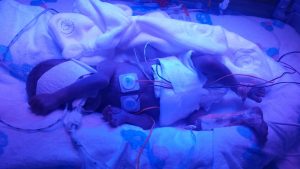
Only I was allowed to touch him but couldn't hold him yet.
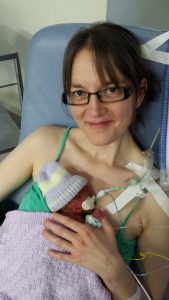
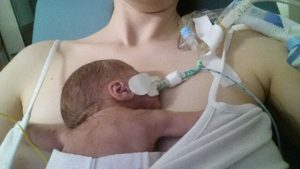
It felt complicated at first getting used to the technique of wrapping and because of all the monitoring it would often take someone else to help me get all the wires sorted, but once Alex was put into the sling he fell straight to sleep. I noticed that often his heart rate and oxygen sats would improve too and it made me even more determined to keep him close.
Our journey through special care gives me mixed emotions. On the one hand I would never wish this experience on anyone. The constant stress, not just for myself but also family and friends around me. The fear that if I leave, something might happen. Every time the phone rang panic would set in and don't even get me started on the paediatricians coming up to the ward!
However, my life has changed completely in so many good ways. I have realised and experienced how fantastic the care is from my colleagues. I have become closer to my family and friends and I love watching my parents with Alex. I feel I will be an even more sympathetic and understanding midwife and I hope my practice will change to support women who go through similar experiences. Most of all I have realised my dream of becoming a mum and to the most incredible little fighter I have ever met.
I feel I have a strong bond with Alex and many people have commented on how well I can read him. I believe it is because of staying close to him as much as I have and having him in the sling has facilitated this.
Alex has Chronic Lung Disease and came home on oxygen in March. He is doing incredibly well on the lowest level now, but transporting the oxygen has been a bit of a challenge for me. The canister is heavy and the container rucksack has narrow shoulders so has hurt my shoulders; trying to balance that weight against Alex has not been easy. At times I have felt isolated simply because of that. However I have met some wonderful people on my journey through special care and in the sling community (often the two groups mix!) and we wouldn't be where we are now without these challenges.
We are still using our Hana wrap, and I've been trying out a snuggly Sleepy Nico! I've learned how to use woven wraps; we are beginning to back carry; the end of the oxygen is in sight! Time to tuck Alex up into the Sleepy Nico and reconnect after a long day.
Positive Effects of Carrying for Society
The positive effects of carrying for society are many; making a change at an individual level can have a significant impact when lots of people do it! In-arms carrying and using slings is one way that we can change the future that we all have to live in.
Possibly one of the most important positive outcomes for carrying for a parent and the society we live in is the effect it can have on mental health, which is a society-wide issue.
Western society is increasingly fractured and isolated, with a decreased sense of local community and shared care. The burden of mental unwellness in our society is growing, and becoming a parent with this background can be very tough indeed.
The birth of a baby is often an overwhelming time for both parents, especially when also faced with the expectations and demands of a fast-paced culture that often judges people by their apparent productivity and appearance. It is no wonder that postnatal depression is on the rise – affecting at least 10-15% of new mothers. This is likely an underestimate as parents feel ashamed to admit their feelings, with the effects of hiding their struggle having significant knock-ons for the whole family.
Fathers are often unrecognised to have the condition themselves, and this all adds to an increased risk of children coming to harm. This is a terrible indictment on our culture and its lack of care for some of the most vulnerable individuals in our communities.
The way we live now isn’t going to change overnight; funding for parental leave or greater support for mental health isn’t going to become suddenly available, and the media bombardment of products for parenting won’t vanish. But neither are the emotional needs of young children going to go away, especially if we want them to grow up well and be happy, confident mature individuals who are well integrated into society.
We need to find ways to nurture our children while still functioning as our culture expects us to, and this is where carrying children (often using a sling) can help. Carrying children encourages and protecting parent’s precious closeness with small children while helping to build the bonds that will be the foundations for a positive future. Giving children a secure and confident start in life pays dividends later for the whole of society.
- Families who enjoy secure attachments and strong bonds are more likely to weather the early years of parenting safely and build resilient children with a secure self-esteem. This will help to counteract the growing burden of mental "un-health" especially as funding for mental health services continues to decrease. Carrying (and using slings), via oxytocin release, helps to build these bonds; and can improve resilience to the Adverse Childhood Experiences that so many children experience. Read more about ACE's here.
- Anything that improves mental health and assists families struggling with PND is worth investing in, especially something as accessible and low cost as a carrier.
- A very sobering review of international attachment studies done by the Sutton Trust found that infants under three years who do not form strong bonds with a parent “are more likely to suffer from aggression, defiance and hyperactivity when they get older.” They found that up to 40% of children lack this secure bond with their parents, and this is likely to lead to their own children also suffering from insecure attachment; a vicious, repeating cycle. “Parents who are insecurely attached themselves, are living in poverty or with poor mental health find it hardest to provide sensitive parenting and bond with their babies.”
- They also found that children with weak attachment were more likely to be obese later in childhood (with subsequent effects on their long term adult health).
- Communities are the normal social structures of the human species; finding common ground and sharing the strains of life together keeps us going. Many families find community among like-minded parents; most sling users make strong supportive friendships within the sling community.
- Carrying keeps us active; movement is essential for health and fitness. Dynamic carrying in arms (if possible) helps children to hone their growing neuromotor skills, and carrying young children (or those with tired legs) is good for adults too; bone remodelling, muscle health and posture.
- As the rates of breastfeeding are higher in carried babies, the health benefits of breastfeeding will be more marked in societies who carry a lot (reduced breast cancer risk, reduced osteoporosis, increased transfer of antibodies, to name just some.)
- Babies who are carried are more content and cry less. Crying is very stressful; and successful calming of a distressed baby will build a parent’s confidence in their ability to care for their child and also reduce the feelings of tension in social gatherings or in large public open spaces.
- Carried babies may have had less ear infections, less corrective treatment for plagiocephaly, and thus have been less in need of the NHS budget.
I believe that health care professionals should therefore promote frequent carrying of infants to achieve the best possible outcomes for families, and for the long term benefit of the societies they live in. It is a low cost intervention that can have far-reaching effects.
Slings and Exercise
 Movement is good for you!
Movement is good for you!
Many people wonder about slings and exercise; can they be done safely together?
Movement and being gently active in the early months after your baby is born is good for your mental health and can help with low mood. Being able to get out of the house and enjoy some fresh air and activity with your child can be great, especially if they are at your height and you can interact and chat and share the experience of the world happening around you together. A sling can be a great way to help this to happen - keeping your child safe while you get on the move. Walking with your baby held close and comfortably, building up your tolerance as your body recovers from birth is all you need. It can be a great way to spend time with other people; the endorphins from activity and fresh air can help with the low mood so many 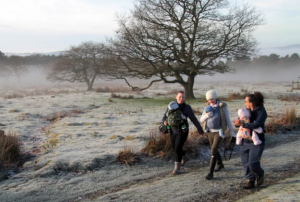
Take your time!
However, doing too much too soon can be unhelpful in the long run, for your body's recovery from birth. Every mother's body is different, and your level of fitness before and during pregnancy will also play a part. Pushing yourself too far too fast can play havoc with wound healing, with slower cessation of bleeding, with prolonged problems with pelvic floor issues, for example. Take your time. There is no need to spring straight back into your pre-birth activities.
Don't fall into the trap of believing that you need to "get your body back as soon as possible." For a mother, the act of bringing life into the world is transformative: your body will never be the same again, and that is a great thing, one to be proud of!
It is good to be fit and healthy, but there is a time for nurturing the new life you have brought into the world, resting and growing together, and a time for weight loss and organised fitness. Simple walking with your baby in a comfy well-fitting carrier and spending time with friends may be all you need for the first few months, for mood lifting and gentle exercise. Does your local sling library organise babywearing walks, or why not start your own?
Points to Consider
If you decide you would like to join fitness or dance or any other classes that have a sling component as it seems a good option for your needs, here are some useful points to consider.
Is your body ready?
- This is very important. Pregnancy and birth have an impact on the core postural and abdominal muscles and the pelvic floor; it takes time for these to recover. Floors may be weak, but they can also be over-tight, both cause problems.
- Overloading still-recovering tissues with certain stretching or weight-bearing activities with the extra weight of a child in a sling (especially if it is poorly fitting or worn low and loose) is not wise, and may end up delaying recovery and causing more long term damage. Wide and deep squats (as opposed to narrow based with vertical shins), side lunges and jumps/bounces, for example, are all inappropriate until pelvic floor function is restored.
- Good posture (with aligned shoulders, pelvis/hips, knees and ankles) matters; many mothers walk with a sway back shape, out of habit or to balance weight of baby, or stand with one hip jutting out. This strains the floor and the core and needs to be addressed.
- Walking with a baby in the sling, ensuring good alignment and posture, gradually increasing the speed and duration, is usually enough exercise for most women in the early months.
- Please do not rush; pelvic floor dysfunction is very, very common (14 million women in the UK are known to have an issue, and many many more never seek help and remain undiagnosed).
- Leaking is NOT normal or to be expected, if you leak with a baby in a sling, on coughing or laughing, you have pelvic floor dysfunction. If you are unsure if your pelvic floor is recovering normally, please see your GP.
Do you have a good carrier to keep your child safe and keep you comfortable?
- As with all things: your sling is never a substitute for alert responsiveness and your focus should always be on your child and their needs. A sling should hold them comfortably and safely with airway protection and neck support (ideally by appropriate seated positioning that meets the TICKS guidelines). Movements should never allow a baby to be shaken, and should always be done with their head and neck position in mind.
- Forward facing out carriers, especially narrow based ones, tend to encourage the baby to lean away from parent, which has an impact on parent's posture, overcompensating for the weight by leaning back. Poor posture can lead to significant health problems.
- It is worth noting that many manufacturer instructions do not recommend exercising with their product; using your carrier for this purpose may invalidate any warranties. Additionally, it is unfortunate that a number of baby carriers are not as well designed as they should be, and their instruction manuals are less than ideal.
Is your baby developmentally ready for this kind of activity?
- Parental activity should never lead to any kind of shaking for children, particularly with young babies whose heads are disproportionally heavy and whose neck muscles are still not fully developed (babies tire very easily as their muscles fatigue).
- Babies should not slump over in the sling during the class and should not fall asleep facing out.
- A good class should respect your baby's development and not include any kind of vigorous repetitive jumping, spinning or shaking movements; your child's safety is the main priority here.
Does the instructor fill you with confidence?
- Does the instructor have appropriate recognised sling training to ensure your baby is kept safe in the sling at all times? It is worth checking, as it shows a good level of preparation and thought.
- Do they know enough about baby anatomy and development and muscle fatigue with certain positions?
- Will they recognise if your child has moved to a position where their airway could be compromised?
- Will they be able to help you correct this (especially if you are not an experienced sling user)?
A good analogy might be a canoe class. If I wanted to attend a class and was required to bring my own life jacket, I might not know which was a reliable brand that would be the most likely to keep me safe. I might ask the advice of a local lifejacket expert, but equally I might buy a cheap one off the internet which has poor instructions that didn't really show me how to keep myself safe or recognise when it wasn't on properly. At the canoe class I would expect that my instructor would be able to give me the once over and check my lifejacket was fit for purpose and on correctly, and would indeed keep me safe, right there and then. I would expect that if my lifejacket began to slip or wasn't in fact on properly during the class, the instructor would be able to identify that and take appropriate measures to remedy this, to keep me safe. I would expect that my instructor would be fully qualified in all aspects of the class - after all I am entrusting my safety to them. Their position of authority means I am more likely to assume that they know what they are talking about, and as a newcomer to canoe classes I will take any advice they offer about the equipment used in the class as expert (even if it isn't).
- Does your instructor have appropriate qualifications to ensure your postnatal body will not be inappropriately overloaded by the extra weight of baby with the movements in the class? If they have recognised post-natal training they will be happy to share this.
- Do they enquire about your overall fitness and pelvic floor health and adapt the routines for your needs? The "six week check" at the GP is not sufficient "sign off" (very few GP's have the time to discuss exercising at the postnatal check, if there is one at all!)
- Do they come across as truly well researched and acting in your best interests?
- Are they taking your and your child's wellbeing as seriously as you do?
- Are they being responsible?
I feel strongly that there are many risks involved in taking part in organised classes for fitness/dance with slings. I would urge all my readers to think very carefully before getting involved with anything that has any kind of vigorous movements such as jumping, bouncing, spinning, and so on. Babies need our loving focus, care and attention; their safety must remain the first priority at all times. Your body's recovery matters too; take your time!
Do speak to your local sling librarian/consultant (Sling Pages has a list) about any classes you are considering before you go - they will be able to advise you on its suitability and help you find a sling that will work well if they feel the class is safe. There are some well-set up and well trained franchises or individual providers who do take their responsibilities towards you and your baby seriously.
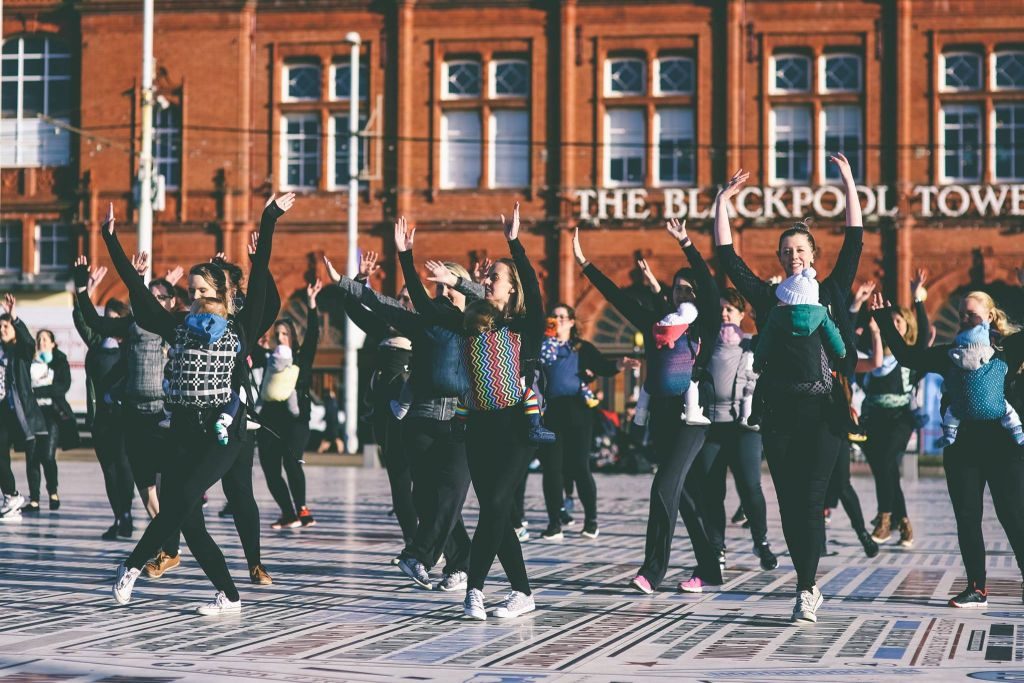
Further Reading
This post on Babywearing Exercise is extremely helpful for further reading and should be read by anyone investigating such classes. Thanks to Emma at SlingSure & Fife Sling Library for this.

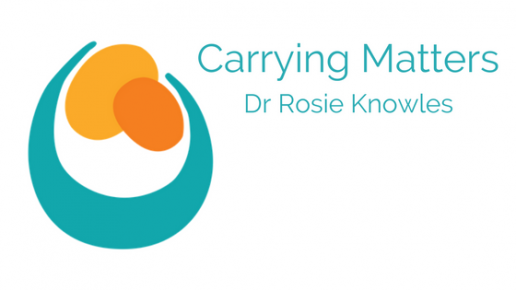
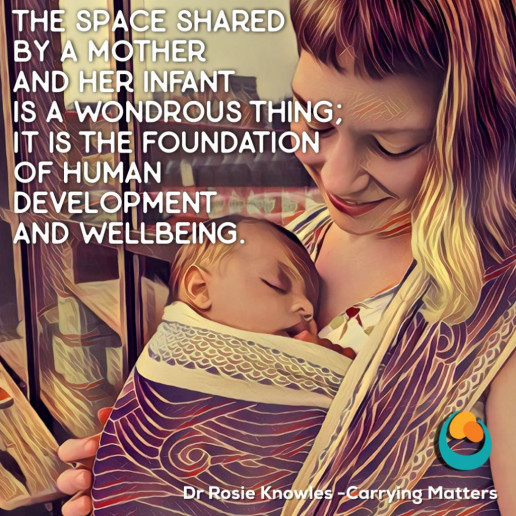
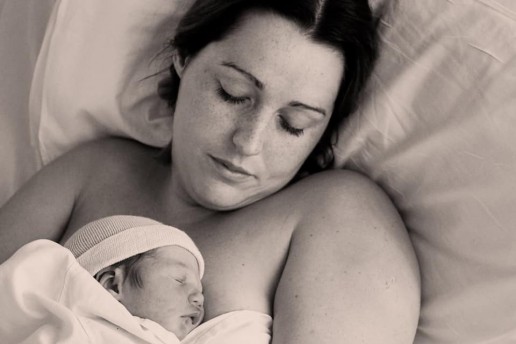
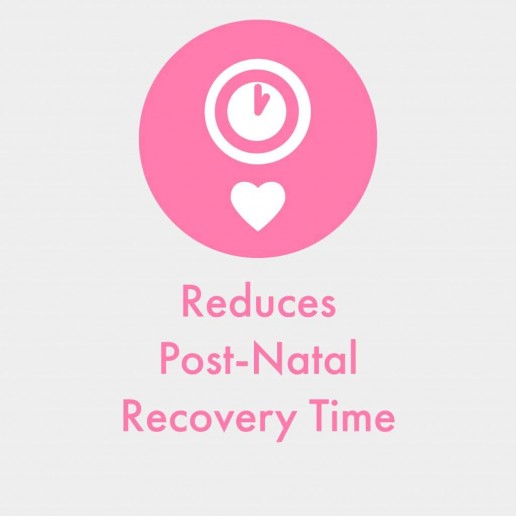
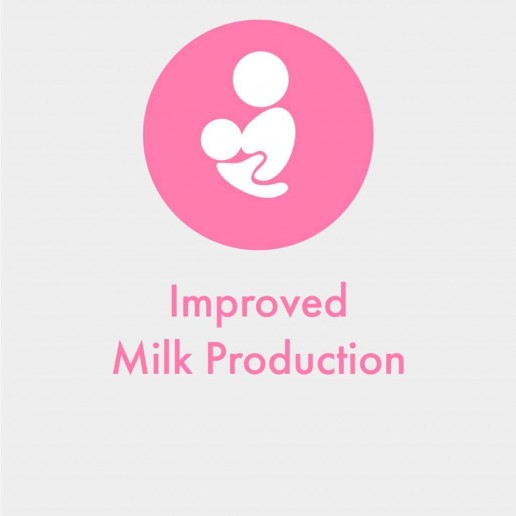
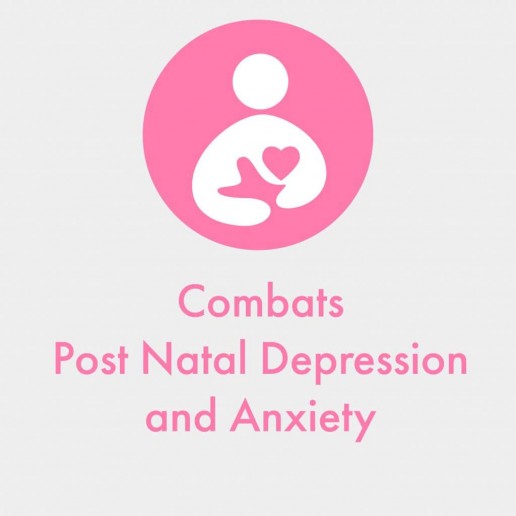
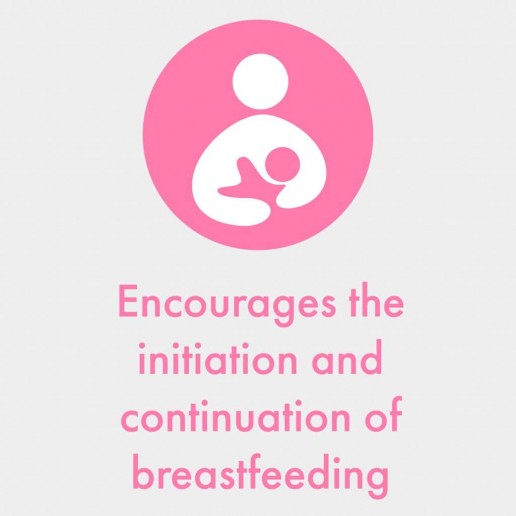
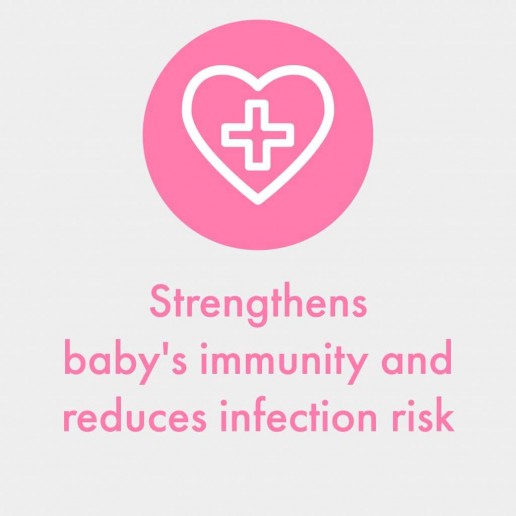
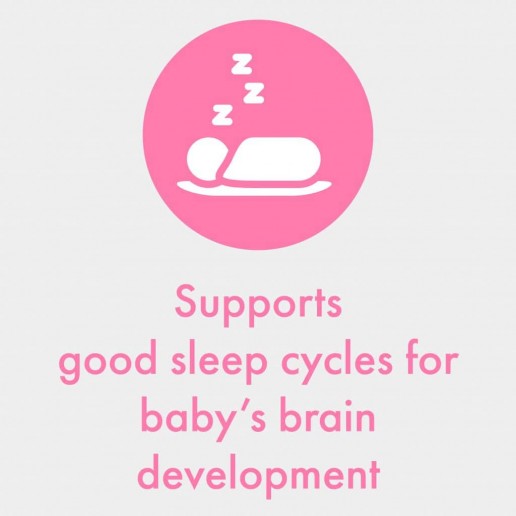
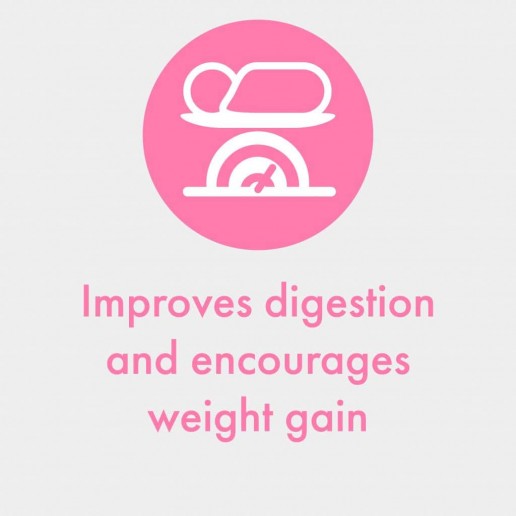
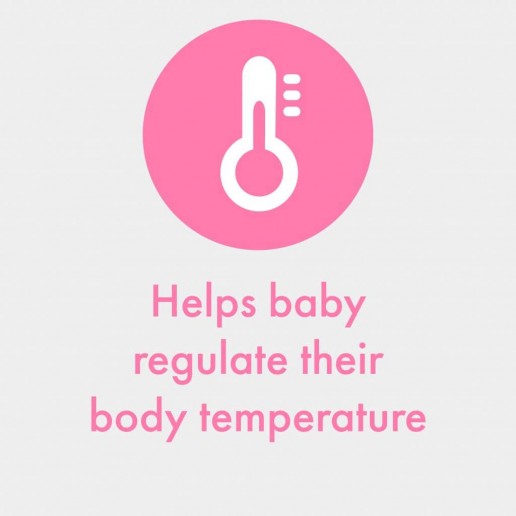
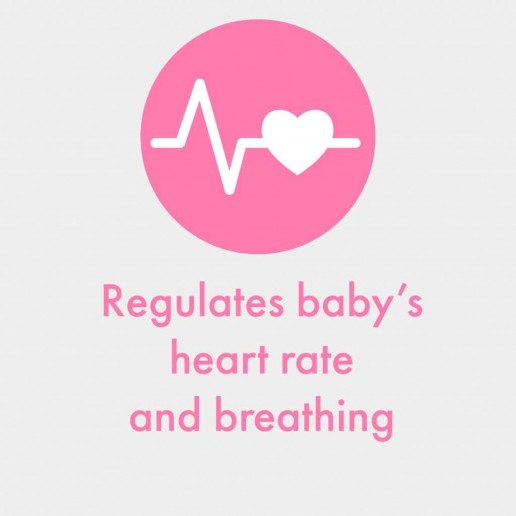
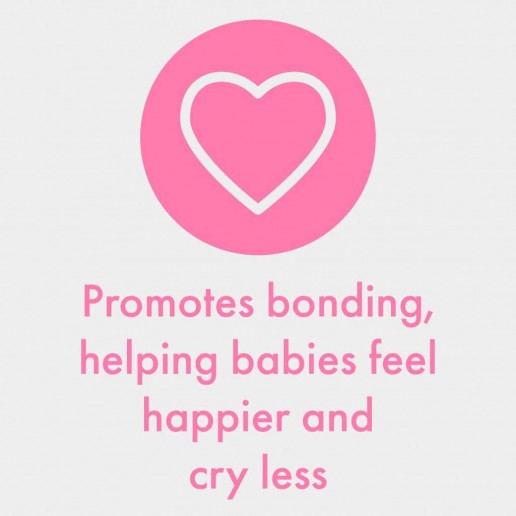
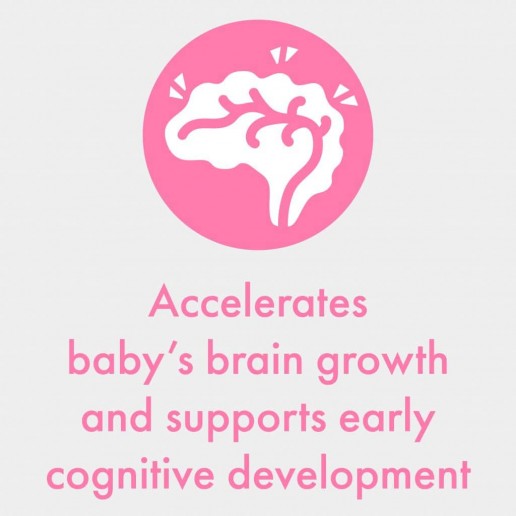
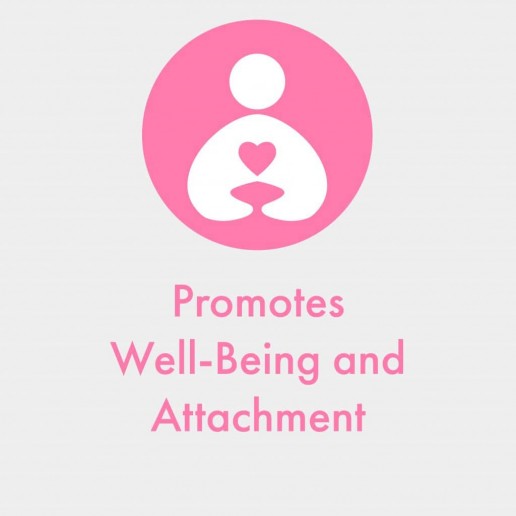
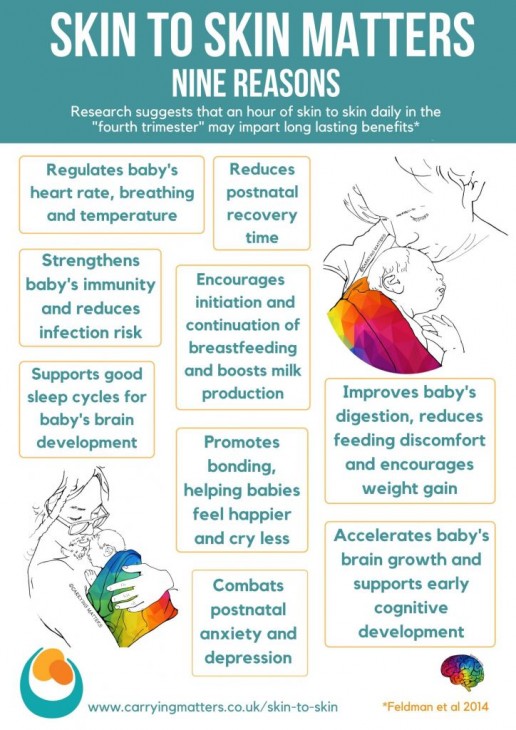
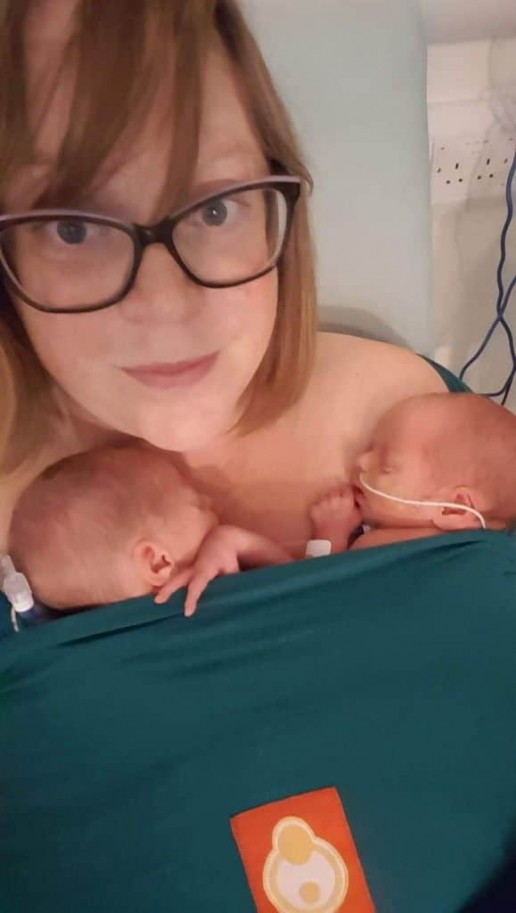
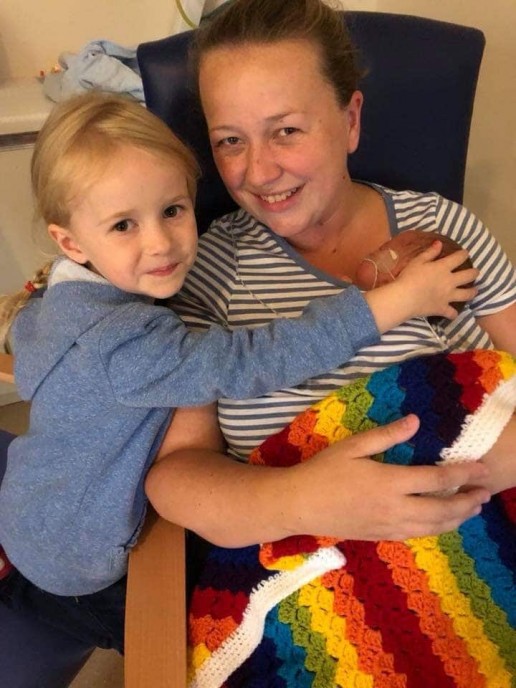
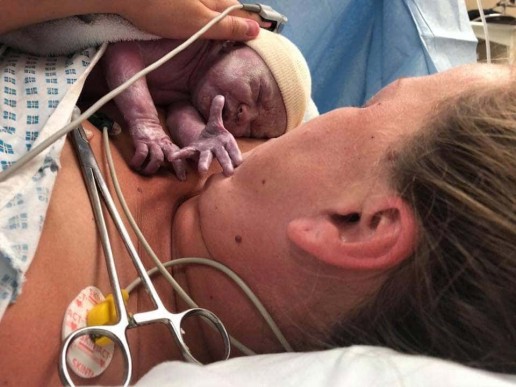
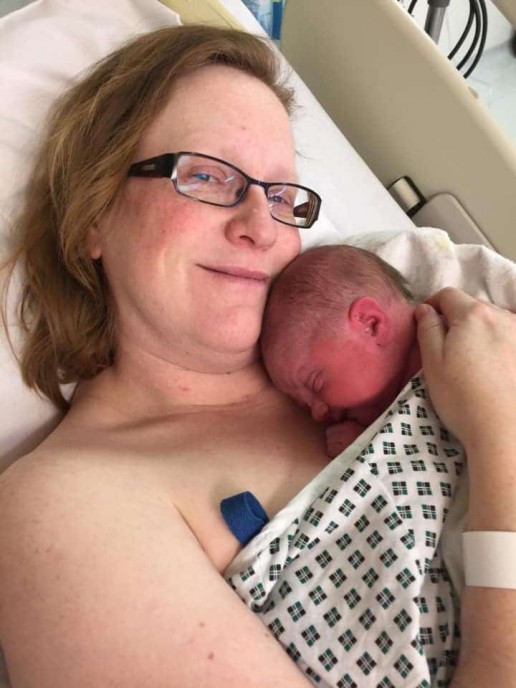
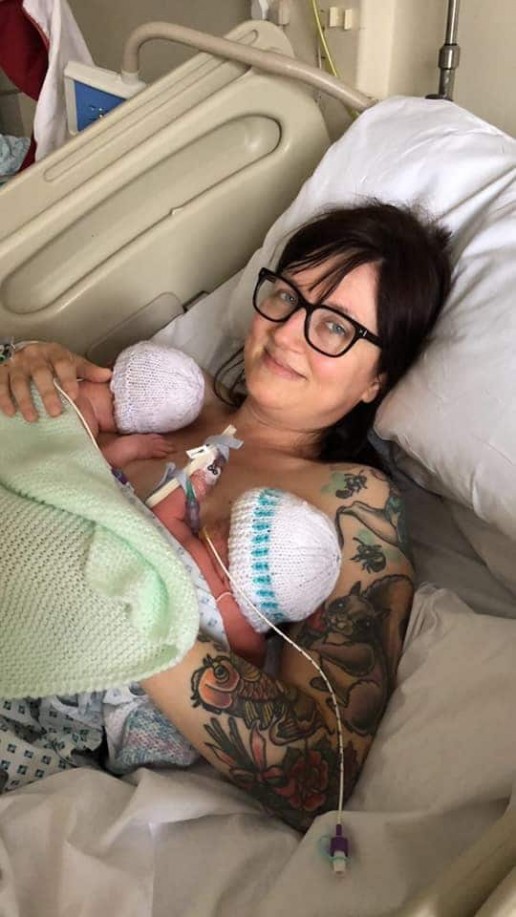
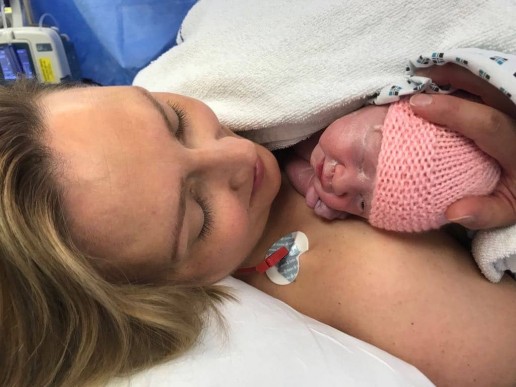
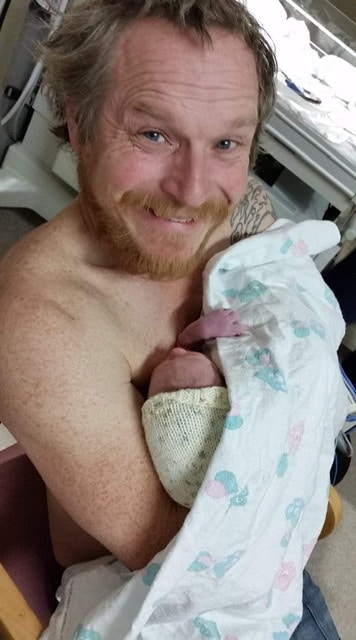
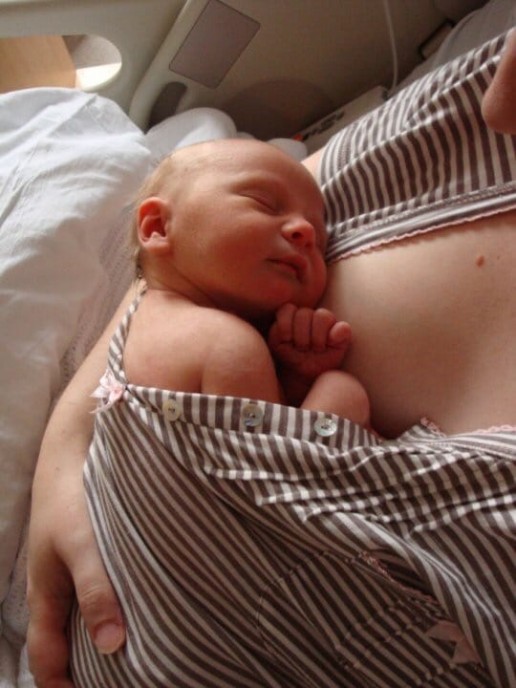
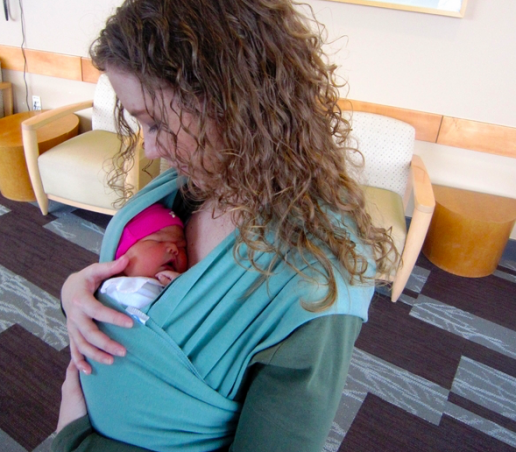
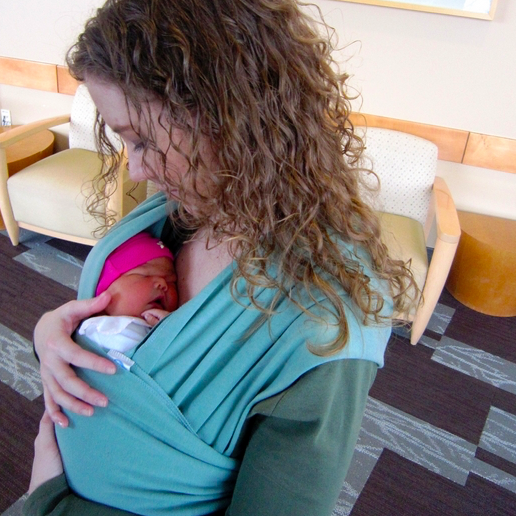
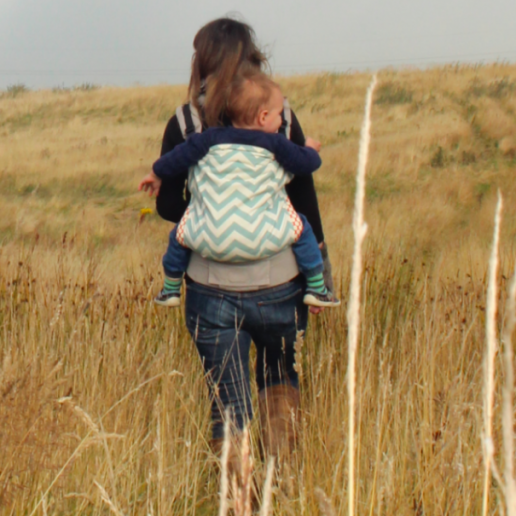
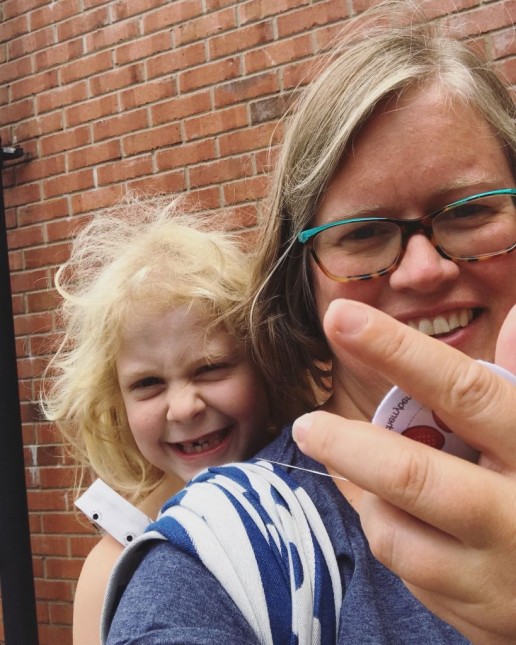
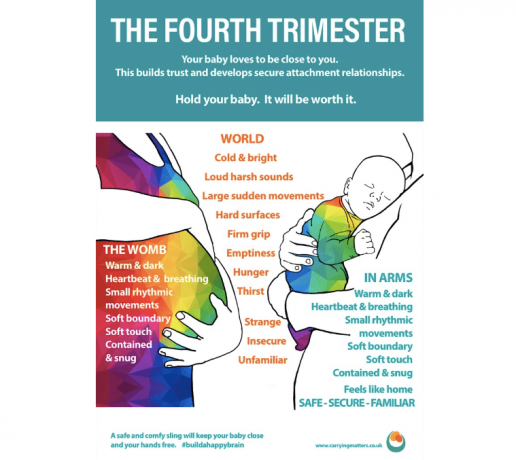
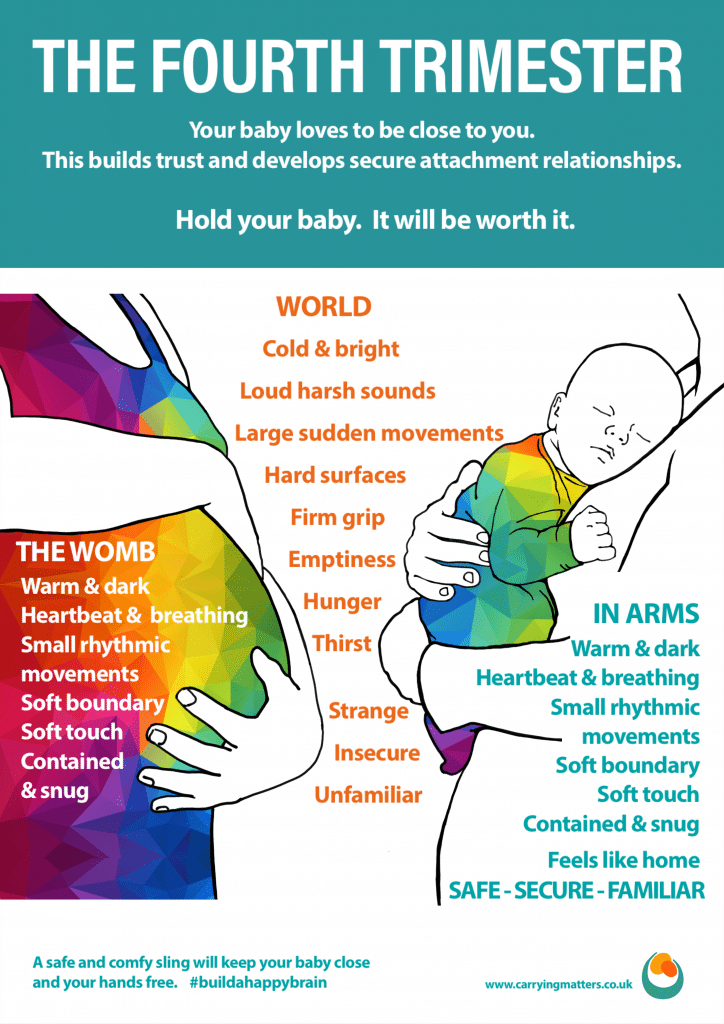
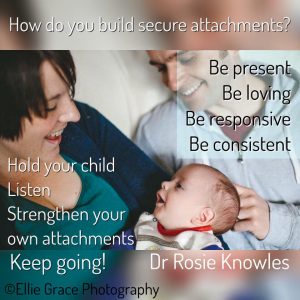

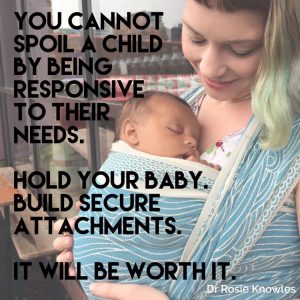
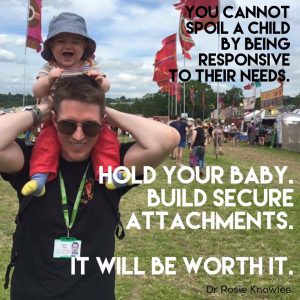
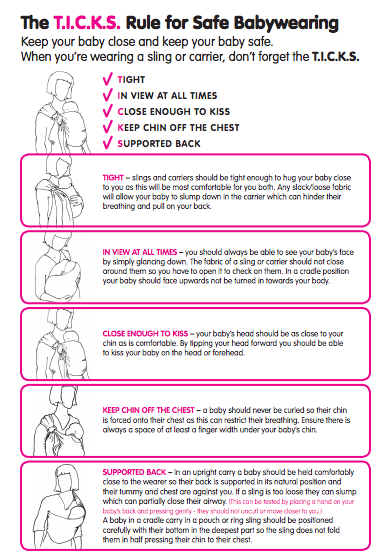
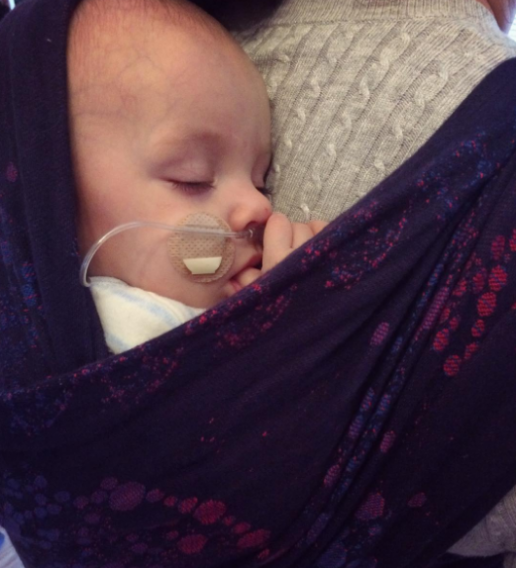
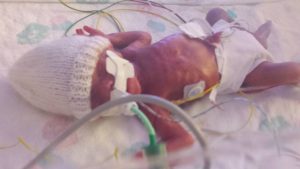
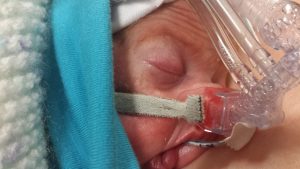
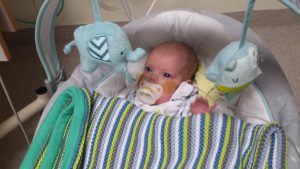
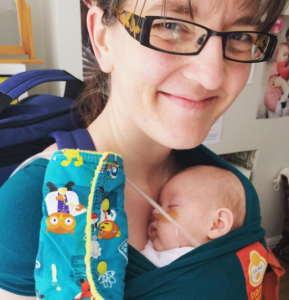
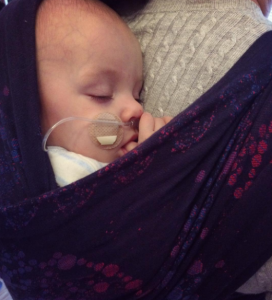
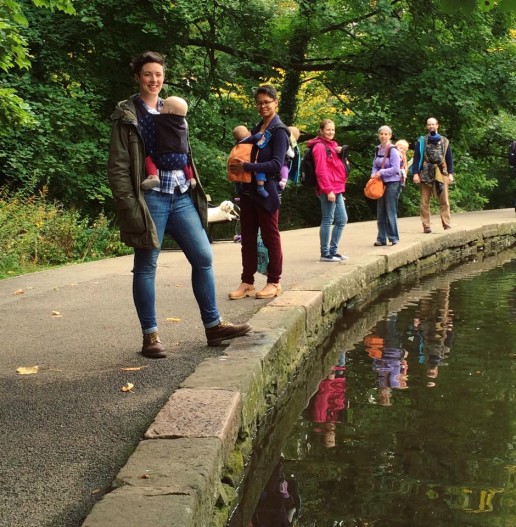
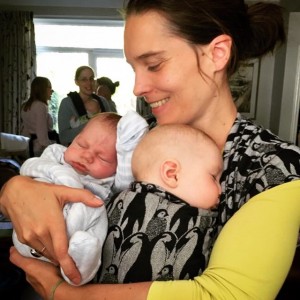
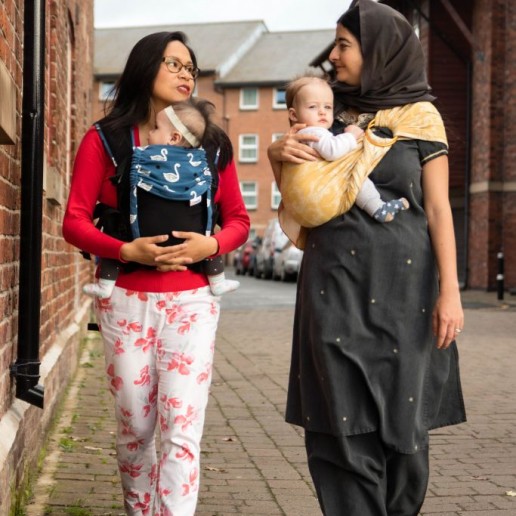
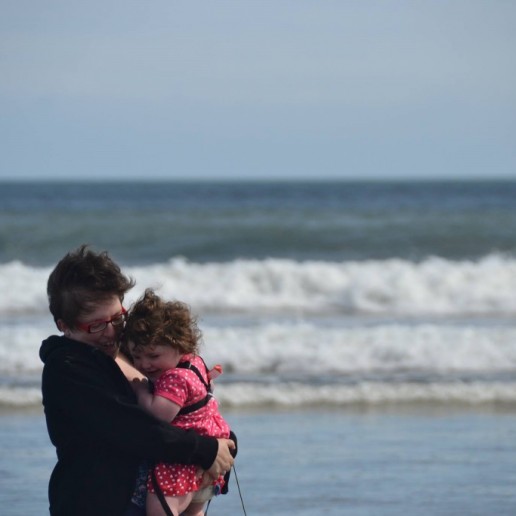
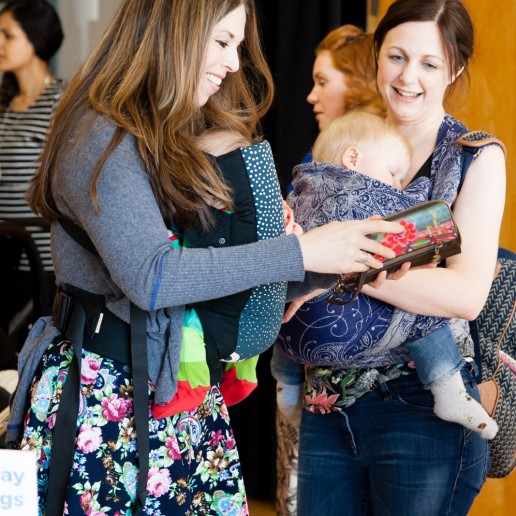

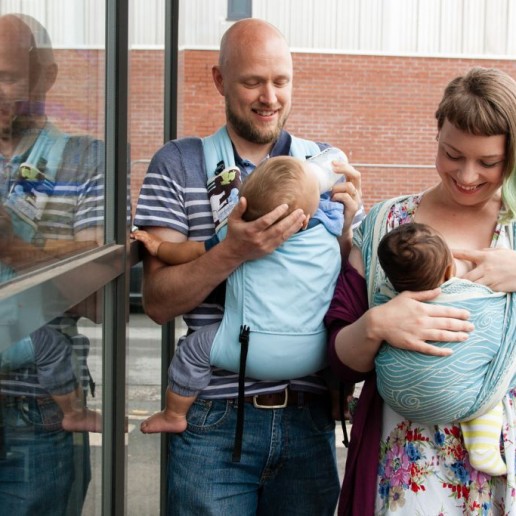
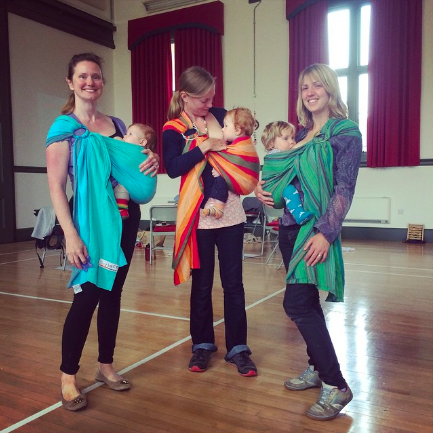
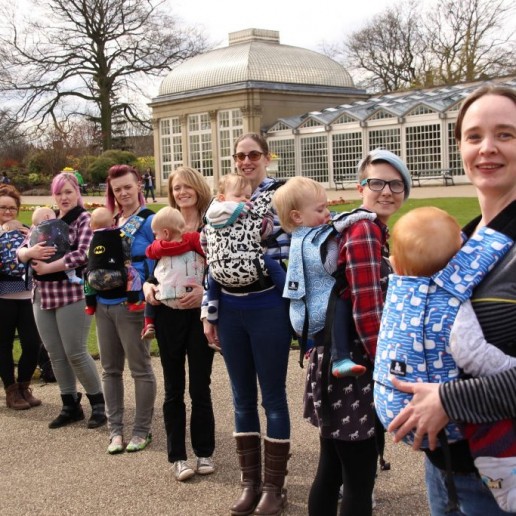
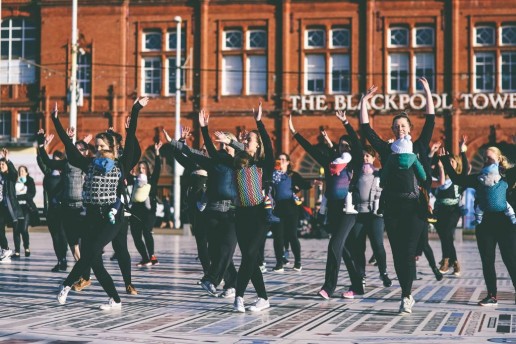
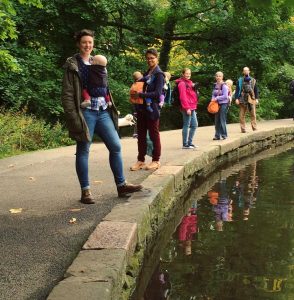 Movement is good for you!
Movement is good for you!